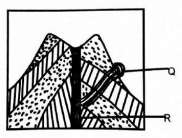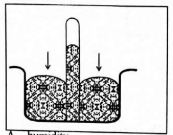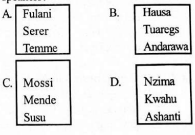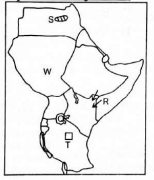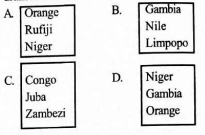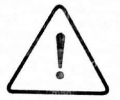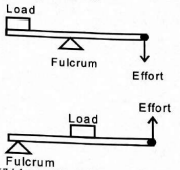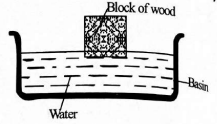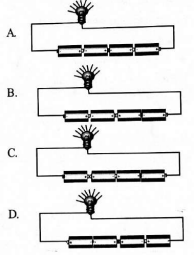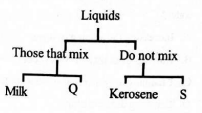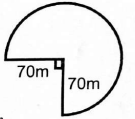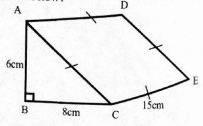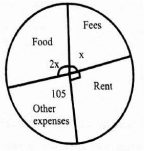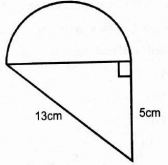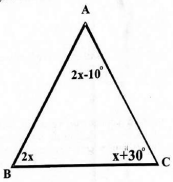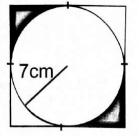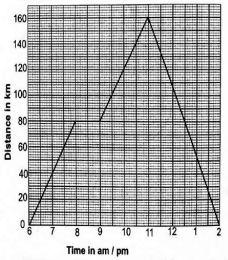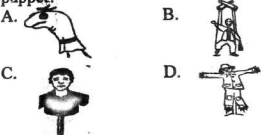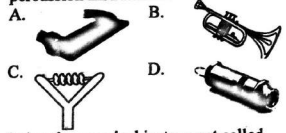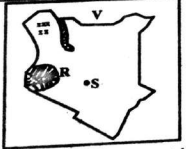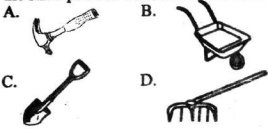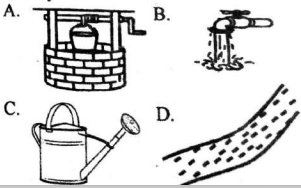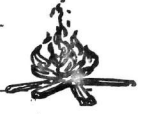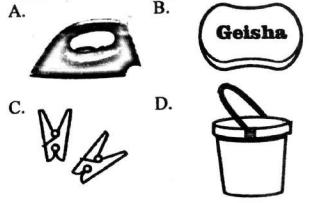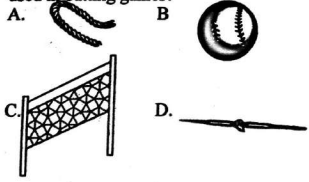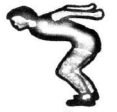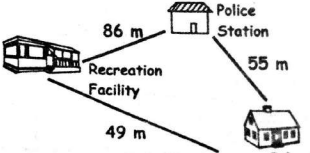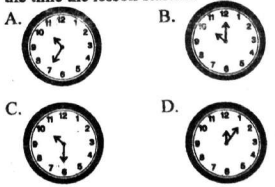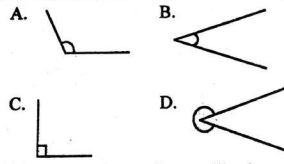Stella
Social Studies & Religious Education Questions and Answers - Class 8 Mid Term Exams Term 1 2023 Set 2
PART I: SOCIAL STUDIES
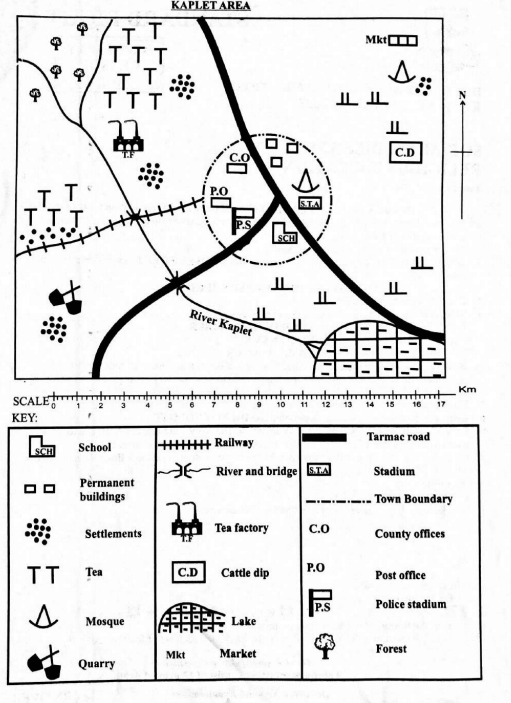
Study the map of Kaplet Area above and use it to answer questions 1 to 7.
- The railway in Kaplet area is likely to transport?
- Tea to the factory
- Passengers to the town
- Tourists
- Minerals
- The area covered by the lake is likely to be __________________________ km2.
- 13
- 9
- 8
- 17
- The climate in the South Eastern side of Kaplet area is likely to be
- cool and dry
- hot and dry
- hot and wet
- cool and wet
- The dorminant soils in the North western side of Kaplet area is
- alluvial soils
- clay soils
- volcanic soils
- black cotton soils
- Three of the following are sources of livelihood for people in Kaplet area. Which one is not?
- Lumbering activities
- Mining activities
- Farming activities
- Trading activities
- Which one of the following services are not offered in Kaplet town?
- Recreational services
- Educational services
- Health services
- Religious services
- Kaplet area rises from
- North west
- North EastC
- South West
- South East
- Settler farming in the white highlands was mainly done for
- commercial purposes
- Food production
- Subsistence use
- Home use
- Which one of the following is true about the population structure of India?
- Most of the people are old
- There is low death rate
- The population growth rate is low
- The birth rate is high
- One of the following is not a problem associated with rapid industrialization. Which one?
- Rural - Urban migration
- Better economic development in the country
- It can lead to depletion of resources
- Pollution
- Which one of the following is not an effect of the rotation of the earth? It causes
- day and night
- different seasons.
- difference in time
- apparent movement of the sun
Use the diagram below to answer questions 12-13
- Name the parts marked Q and R respectively
- conelet, vent
- dyke, magma
- conelet, dyke
- crater, vent
- Which one of the following mountain was not formed in the above way?
- Mt. Longonot
- Mt. Ruwenzori
- Mt. Kenya
- Mt. Nyirangongo1
- The following are examples of industries. Which one can be classified as a primary industry?
- Shoe making at Limuru
- Cement making at Athi river
- Textile industry at Kisumu
- Sugar refining at Awendo
- The system of administration used by the British in Northern Nigeria was
- direct rule
- assimilation
- paternalism
- indirect rule
- Below is a weather instrument. It is used to measure
- humidity
- temperature
- air pressure
- rainfall
- Which one of the following boxes consist of communities that belong to the KWA speakers?
- The following are characteristics of a type of marriage
- it is conducted by a religious leader
- A marriage certificate is issued
- a man is allowed to marry upto four wives
The type of marriage described above is likely to be- Christian marriage
- Hindu marriage
- Customary marriage
- Muslim marriage
- Copper is a major mineral in Zambia it has all the following uses except?
- Making water pipes
- Making sulphuric acid
- Making car radiators
- Making ornaments
- Which one of the following best explains why the government has established game parks and game reserves?
- To conserve wildlife
- To attract tourists
- To create employment
- To make good use of land
- The following are characteristics of a climatic region in Africa?
- it experiences cool wet winters
- summers are hot and dry
- Annual rainfall is about 500-1000mm
- temperatures range from 13°c - 24°c
Which one of the following is not likely to experience this type of climate?- Morocco
- Algeria
- South Africa
- Zimbabwe
- Who among the following leaders were associated with African socialism?
- Oginga Odinga and Ronald Ngala
- Jomo Kenyatta and Daniel Moi
- Tom Mboya and Jomo Kenyatta
- James Gichuru and Masinde Muliro
- Which one of the following is not a reason why people should vote in the national elections?
- To elect a new government
- To exercise their democratic right
- To elect leaders of their choice
- To obey the laws of Kenya
Study the map of Eastern Africa below and answer the questions that follow.
- The capital city of the country marked W is
- Khartoum
- Juba
- Mogadishu
- Addis Ababa
- The pre-historic site marked T is likely to be
- Olduvai gorge
- Hyrax hill
- Omo valley
- Rusinga island
- The lake marked Q was formed through a process called
- Faulting
- Downwarping
- Erosion
- Volcanicity
- Name the desert marked S
- Namib
- Ogaden
- Chalbi
- Nubian
- All the following communities followed the route marked R. Which one did not?
- Rendille
- Somali
- Oromo
- Maasai
- The following describes an early visitor to Eastern Africa
- He was a German
- He signed treaties with African chiefs
- He was the founder of the German East African Company (GEACE) in 1887.
The visitor described above is likely to be- William Mackinnon
- Seyyid Said
- Carl Peters
- John Speke
- The feature drawn below is likely to be fund in the
- desert
- coastal lowlands
- highlands
- lake basin
- The main reason why the government is encouraging the conservation of natural forests in Kenya is because
- they control desertification
- they contain rare species of trees
- they control soil erosion
- they are habitats for wildlife
- Below are descriptions of a certain hominid
- made tools from stones
- communicated through speech
- ate cooked food
The hominid described above is likely to be- Homo Erectus
- Homo habilis
- Ramapithecus
- Australopithecus
- The following are problems experienced by IGAD except
- lack of peace
- mistrust among members
- prolonged drought
- lack of common currency
- In a democratic society
- people join the ruling party
- only one political party is allowed
- elections are held regularly
- citizens are forced to pay taxes
- Mzee Torotich a maize farmer in Kitale has bought land and settled in Kinangop where he grows potatotes. This type of irrigation is called
- urban-rural migration
- urban-urban migration
- rural-urban migration
- rural-rural migration
- Which one of the following sets of rivers drain into the Atlantic ocean?
- One of the duties of the school board of management is to
- employ teachers
- plan and develop school projects
- punish indisciplined children
- sack non performing teachers
- Which one of the following skills was not learnt through apprenticeship during the pre-colonial period?
- Wood carving
- Iron smelting
- Herding
- Medicine
- The following are disadvantages of irrigation schemes. Which one is not?
- They contribute to the spread of diseases
- They lead to global warming
- They lead to reduction of water in the rivers
- They support growth of food crops which are cheap
- Which one of the following is not a cause of soil erosion?
- Heavy rainfall
- Monocropping
- Overgrazing
- Strip cropping
- The people who founded the kingdom of old Ghana obtained their wealth mainly from
- weaving
- hunting
- trade
- fishing
- An elected county representative can lose a seat if
- the election is cancelled by a court
- the person visits anther country
- the person misses 5 consecutive sittings
- the person does not contribute to debates in the county assembly
- The best action to take if a pupil is sexually abused by a stranger is to
- rash the pupil to the pharmacy and buy ARV drugs
- arrest the stranger
- take the pupil to the hospital
- advise the pupil not to use that route again
- The following are descriptions about a certain community in Africa
- decisions were made through concensus
- they were hunters and gatherers
- they traded with their neighbours
The community above is likely to be- The San
- The Buganda
- The Nyamwezi
- The Khoisan
- During the pre-colonial period, people associated the croaking of frogs with
- the coming of a dry season
- the coming of a good harvest
- the coming of rains
- the coming of strong rains
Use the diagram below to answer questions 46-47
- The diagram above shows the formation of
- land breeze
- sea breeze
- orographic rainfall
- Cyclone
- Which one of the following towns is not likely to experience the above phenomenon?
- Kisumu
- Mombasa
- Dar-es-salaam
- Arusha
- If a person is stopped from joining a legal party of his choice he / she is denied the freedom of
- speech
- politics
- movement
- association
- One of the following was a function of a clan in the traditional African societies. Which one is not?
- Settle disputes
- Predict the future
- Defend the community
- Train warriors
- Which one of the following may lead to high population growth rate in a county?
- Cases of early marriages
- Family planning practices
- Change in cultural attitudes
- Education and awareness
- Minutes of a school management committee meetings are written by
- Deputy headteacher
- The chairperson
- The headteacher
- One of the teachers
- Who among the following African leaders resisted the French in his territory?
- Chief Mkwawa
- Mekatilili wa Menza
- Samoure Toure
- Kabaka Mwanga
- Which one of the following is the reason why Madaraka day is celebrated in Kenya?
- To remember the day when Kenya attained self government
- To remember freedom fighters
- To celebrate independence day
- To celebrate the day Kenya became a republic
- The road sign below means
- bumps ahead
- slow down
- danger ahead
- round about
- Gamal Abdel Nassaer promoted agriculture in Egypt when he
- set aside land for plantation farming
- initiated the building of Aswan High dam
- gave land to the peasants
- abolished Sharia laws
- Which one of the following sets of countries consists only of those colonized by the French?
- Libya, Somalia, Egypt
- Senegal, Cameroon, Congo
- Angola, Nigeria, Mozambique
- Algeria, Mali, Senegal
- Which tourist attractions below arecorrectly matched with the country where they are located?
- Gedi ruins - Uganda
- Pyramids - Kenya
- Berber villages - Morocco
- Slave markets - Zanzibar
- Which one of the following is not a horticultural crop?
- Cotton
- Pawpaws
- Avocadoes
- Roses
- Cabinet meetings in Kenya are chaired by the
- Speaker
- President
- Attorney General
- Chief justice
- Population census is carried out in Kenya after years.
- 10
- 5
- 20
- 7
SECTION I:
CHRISTIAN RELIGIOUS EDUCATION
- God created the universe in 6 days. On which day did He create the sea, creatures and birds
- 2nd
- 4th
- 5th
- 6th
- "Never against shall I destroy my people with water" God made a covenant with Noah. The sign of the covenant was
- Dove
- Rainbow
- Raven
- Fire
- Abraham separated with Lot due to
- jealousy
- hatred
- enemity
- quarrels over grazing lands
- Which gift of the holy spirit did Joseph have which made him famous in Egypt?
- Interpreting dreams
- Working miracles
- Artistic talent
- Was a good speaker
- Why did Moses decide to leave Egypt to go and live in Midian?
- To look for the burning bush
- To escape from Pharaoh
- To look for Jethro's herd
- To receive the ten commandments
- Which one of the following achievements of David made Jerusalem a centre of worship? He _______________________
- built the temple
- brought back the ark of the covenant
- killed Goliath
- fought 5000 men
- "My clan is the weakest in the tribe of Manasseh and I am the least important member of my family." Who spoke these words
- Gideon
- David
- Isaiah
- Joseph
- Which one of the following is the reason why king Solomon is remembered as a great king of Israel. He ____________________
- bought the ark of the covenant to Jerusalem
- had many wives
- had great wisdom
- built the lord's temple in Jerusalem
- Which one of the following is not a prophecy of prophet Isaiah about the work of the Messiah. He would
- preach good and to the poor
- give sight to the blind
- lead Israelites free from the Roman rule
- set the oppressed fire
- Why was Mary greatly troubled by the angel's message during the annunciation of the birth of Jesus?
- She was engaged to Joseph
- she was a virgin
- she feared the angel
- she was barren
- Who ordered for a census to be done when Jesus was born?
- Pontius Pilate
- King Herod
- Augustus Caesar
- Governor Quirintius
- Complete the following beatitude: Happy are these who are humble
- for they will see God
- God will be merciful to them
- the kingdom of heaven
- they will receive what God has promised
- Which of the following parables of Jesus teaches about forgiveness
- the good Samaritan
- the prodigal son
- the mustard sad
- the net
- Which of the following teachings of Jesus about prayer is true?
- God answers prayers immediately
- It should be said in humility
- Prayer should be long
- It should be said in groups
- Cleophas and his friend were talking to Jesus without realising till he
- prayed with them
- broke the bread
- explained the scriptures
- drank the wine
- Jesus asked His disciples to pray on Mount Olive inorder to
- stay awake
- defend themselves
- avoid falling into temptations
- fight Judas and the soldier
- Which one of the following activities shows a fruit of the holy spirit?
- Telling about the future
- Speaking in tongues
- Caring for the sick
- Conducting bible study
- Before the disciples received the Holy spirit they were in a room in Jerusalem
- sleeping
- praying
- hiding
- eating
- The story of Saul on his way to Damascus teaches Christians to
- support the spread of the gospel
- help there in need
- be kind to the poor
- read the scriptures
- When there was a famine the believers sent Paul and Barnabbas to Judea to
- preach to non jews
- heal the sick
- take money to fellow believers
- place hands on the non converts
- Which one of the following is a role of ancestors in the traditional African society?
- Ancestors act as intermediaries between the living and God.
- Ancestors show the living how to use their talents wisely
- Ancestors remind the living to love their enemies
- Ancestors teach the living on how to pray
- Three of the following are reasons why circumcision is practised in traditional African societies, which one is not?
- The initiates become full members of their community
- The initiates pass from childhood to adulthood
- The initiates are allowed to marry
- The initiates become chiefs
- Which one of the following traditional African practice concerning new life is illegal in Kenya?
- Naming
- Taking
- Circumcision
- Female genital mutilation
- Which of the following statements is true of both christianity and traditional African religion?
- They both teach about the second coming of Jesus
- They both have holy books
- They both have missionaries
- They both teach about life after death
- Christians best prepare themselves for Easter by
- repenting their sins
- buying new clothes
- visiting their friends
- preparing special food
- After assisting her mother in kitchen. work, Daisy realizes that she had some extra time. As a christian the best way to spread it is by
- reading story books
- watching films
- visiting her friend
- visiting an orphan
- Which one of the following is not a reason why the taking of alcohol as a way of spending leisure is condemned.
- It leads to conflicts within the family
- It leads to irresponsible sexual behaviours
- It promotes mental health
- It could lead to a loss of income
- Dennis, a standard eight pupil has been receiving gifts from an elderly rich woman who wants to have a relationship with him. As a christian the right action for him to take is to
- transfer to another school
- inform other pupils about the roman
- report the matter to the headteacher
- accept the gifts
- You have discovered that Bosire your best friend is being used by a rich man to sell drugs to other pupils in school. As a christian you should tell him to
- Transfer to another school
- ask the rich man to pay him well
- sell the drugs and not use them
- stop selling the drugs and concentrate in class
- Which one of the following is a wrong use of money?
- Helping the needy to become rich
- Paying school fees for a relative
- Paying salaries to workers
- Giving gifts to voters
SECTION II:
ISLAMIC RELIGIOUS EDUCATION
- Which one of the following Surah teaches about oneness in Allah (SWT)?
- Al-Fatiha
- An-Nas
- Al-Ikhlas
- At-Kanthar
- The verse 'you do not worship what I worship' is derived from which surah?
- Al-miminim
- Maun
- Al-Kafirun and off
- Zilzala
- The prayer performed between morning and mid-day is called:-
- fajr
- dhuhur
- dhuha
- witri
- The sunna prayer performed during the night of Ramadhan is called:-
- Ishai
- Tarawele
- Istiskai
- Sala tul lail
- Which of the following surah is recited seventeen times a day by muslims?
- Annas
- Al-Fatiha
- Aya tul kursy
- Tyin
- Which of the following can nullify udhu?
- Passing wind
- Speaking
- Applying perfume
- Shaking hands
- Which is the correct order of prayers performed by muslims?
- Fajr, Dhuhr, Asr, Maghrib, Isha
- Fajr, Dhuhr, Maghrib, Asr, Isha
- Fajr, Dhuhr, Maghrib, Isha, Asr
- Fajr, Maghrib, Dhuhr, Isha, Asr
- Which of the following prophet of Allah received Suhuf?
- Ibrahim
- Issa
- David
- Mohamed
- What is the main teaching from Surah Al Alaq?
- All people should be responsible for their deeds
- A man was created from a clot of blood
- Allah is the only forgiver
- Prophet is favoured by God
- Who among the following is not a prophet?
- Zulekha
- Isaak
- Yunus
- Ishmail
- When you visit a sick in the hospital the best gift you can give to him is:-
- a flower
- get well card
- food
- a dua
- When someone gives you a gift you should say:-
- Alhamdulillahi
- Jazakallah
- lahaula wa lakwata
- Audhubillahi
- Islam teaches on hardwork since:-
- it discourages begging
- it discourages laziness
- it is a way of creating wealth
- it is a way of earning lawfully
- Which of the following items is hash for zakat?
- Personal clothings
- House furniture
- Farm produce
- Family house
- When muslims are in need they should seek help from:-
- Mohamed
- Jibril
- Allah
- Imam
- Which one of the following islamic months is not among the sacred months (ash-hunul-human)?
- Rajab
- Muharan
- Dulhija
- Ramadhan
- The lesson derived from the bottle of badr is that prisoners should be:-
- treated kindly
- be forced to work
- be set free
- denied food
- Which one of the following is a halaal business practice?
- Gambling
- Selling alcohol
- Hoarding
- Lending money
- The festival of Idd Id Fitri is celebrated on:-
- 1st shawal
- 30th Ramadhan
- 1st Ramadhan
- 1st Rajab
- Hussein found a thousand shilling note on the assembly ground. What would be the best course of action?
- Share the money with friends
- Take the money to his parents
- Take the money to the teacher
- Use the money to buy school books
- The duty of angel Izrail is to:-
- remove people's souls
- blowing the trumpet
- recording deeds
- bringing rain
- Which of the following attributes of Allah describes Allah as the king of kings?
- Malik
- Kahman
- Al-gudus
- Ar-rahum
- Which one of the following can be classified as light najis?
- Bacon
- Dogs urine
- Urine of a baby boy
- Vomit
- How many rakaas are performed during Fajr prayers?
- 4
- 10
- 8
- 2
- Which of the following are fadh prayers prayed by muslims?
- Dhuha
- Dhuhr
- Tareweh
- Taqwa
- Thuluthul Quran is a title given to surah Ikhlas. This is because Sura Ikhlas is the:-
- mother of the Quran
- a third of Quran
- heart of Quran
- opening chapter
- Muslims lost in the battle of:-
- Badr
- Hunain
- Uhud
- Khadaq
- The two Muadhatein surah are __________________ and __________________
- Nas and Falaq
- Kauthar and Maun
- Nasr and Asr
- Dhuha and Inshirah
- Who is not among the four caliphs of prophet (pbuh)?
- Abbakar
- Abu-jahal
- Ali
- Uthman
- Doing right and avoiding evil wherever we are is a sign of having:-
- Ihsan
- Iman
- Taqwa
- Tawakkal
MARKING SCHEME
SOCIAL STUDIES
- D
- A
- B
- C
- A
- C
- D
- A
- D
- B
- B
- A
- B
- D
- D
- C
- D
- D
- B
- A
- D
- C
- D
- B
- B
- D
- B
- C
- A
- A
- A
- D
- C
- D
- D
- B
- C
- D
- D
- D
- C
- A
- C
- A
- C
- B
- D
- D
- A
- A
- C
- C
- A
- C
- B
- D
- C
- A
- B
- A
C.R.E
- C
- B
- D
- A
- B
- B
- A
- D
- C
- B
- C
- D
- B
- B
- B
- C
- C
- C
- A
- C
- A
- D
- D
- D
- A
- D
- C
- C
- D
- D
Science Questions and Answers - Class 8 Mid Term Exams Term 1 2023 Set 2
QUESTIONS
- Which one of the following minerals works 6. hand in hand with platelets in clotting after an injury?
- Iron
- Calcium
- Phosphorus
- Vitamin D
- Which blood vessel carries pure blood rich in oxygen from the lungs to the heart?
- Pulmonary artery
- Pulmonary vein
- Aorta
- Venacava
- Which of the following pairs of drugs consists only of illegal drugs in Kenya?
- Bhang and mandrax
- Tobbaco and tea
- Coffee and alcohol
- Inhalants and miraa
- Which one of the following stages of HIV/ AIDS infection does one look health with no visible signs but tests positive?
- Incubation
- Window period
- Symptomatic
- Full blown AIDS
- Which one of the following is not a function of the placenta?
- Nourishes the embryo
- Produces hormones that maintain pregnancy
- Facilitates the transfer of wastes
- Lubricates the birth canal during birth
- Which one of the following sexually transmitted infections has a painless sore on the genitals as one of the signs?
- Syphilis
- Gonorrhoea
- Chancroid
- Genital herpes
- A ruler placed slanting in water appears broken. This is because light
- from the part of the ruler under the water is reflected
- from that part of the ruler under the water is refracted
- from that part of the ruler under the water is scattered
- travels straight line from a source
- The diagram below represents a set-up that can be used to demonstrate a certain aspect of heat.
After some time, the wax melted due to;- conduction only
- convection and conduction
- radiation only
- conduction and radiation
- Which one of the following crop pests attacks and destroys crops by drilling holes in stored grains?
- White ants
- Weevil
- Stalk borers
- Cutworms
- Which one of the following plants stores food in the same part of the plant as sugarcane?
- Carrot
- sweet potato
- Irish potatoes
- Cassava
- A bean seed stores food in the
- plumule
- radicle
- testa
- cotyledon
- The following are characteristics of certain animals:
- body covered with scales
- lay eggs
- cold blooded
- breath through lungs
Which one of the following pairs of animal has all the characteristics listed?- Turtle and shark
- Lizard and tortoise
- Tilapia and frog
- Crocodile
- Which of the following is the main constituent of a balanced diet obtained by animals when they feed on rice husks?
- Carbohydrates
- Proteins
- Vitamins
- Mineral salts
- Which one of the following is not an example of rotational grazing?
- Strip
- Paddocking
- Tethering
- Zero grazing
- Which one of the following is the cheapest material for modelling the solar system?
- Clay
- Softboard
- Plasticine
- Pins
- The following are some uses of components of air:
- manufacturing of electric bulbs
- supports burning
- manufacture of soft drinks
- germination of seeds
- putting out fire
Which of the uses are for carbondioxide?- i and ii
- ii and iv
- iii and v
- iii and iv
- A certain lever when in use, can work with load, effort and pivot at different positions as shown in the diagrams below.
Which one of the following levers is described by the diagrams shown above?- Wheelbarrow
- Spade
- Crow bar
- Claw hammer
- Which method of separating mixtures can be used to separate wheat flour from husks?
- Picking
- Filtering
- Sieving
- Winnowing
- In a food chain, which organisms should be the most abundant?
- Producers
- Tertiary consumers
- Primary consumers
- Secondary consumers
- The transfer of heat through solids and gases respectively is
- conduction and convection
- conduction and radiation
- conduction and expansion
- convection and conductions
- The diagram below show a set up that was usedto investigate a certain property of matter.
The block of wood floated on water.This is because of its- material
- shape
- size
- weight
- Materials which allow some light to pass through them but one cannot see them clearly are called
- translucent
- transparent
- opaque
- reflectors
- The largest component of the environment on the surface of earth is
- plants
- air
- water
- animals
- Which water bone disease can be controlled covering pit latrine after use?
- Malaria
- Bilharzia
- Cholera
- Typhoid
- Which type of soil erosion can be prevented by mulching?
- Sheet
- Splash
- Gulley
- Land slide
- Which one of the following is a natural source of light?
- Moon
- Torch
- Electricity
- Firefly
- Which one of the following is true about friction. Friction can be
- Increased by streamlining
- reduced by treading
- used to make work easier
- measured using a spring balance
- Which one of the following food stuffs constitutes a balanced diet?
- Potatoes, beans, eggs
- Chicken, cabbage, beans
- Rice, chapati, beans
- Peas, ugali, spinach
- The diagram below represents a windvane constructed by pupils
A suitable material can be used to make the part labelled Q is- sheet of metal
- piece of mosquito net
- polythene sheet
- sheet of paper
- In which one of the following circuit diagrams will the bulb light?
- Which one of the following is not a way of using water sparingly?
- Reusing domestic water for irrigation
- Use of drip irrigation
- Closing taps that are not in use
- Repairing leaking pipes
- Which one of the following food stuffs contain mainly fats?
- Milk
- Beans
- Peas.
- Bananas.
- The following are characteristics of certain types of clouds
- white in colour
- appear like bundles of cotton
- dark grey in colour
- mountainous in shape
Which pair of features are for cumulus clouds?- (i), (ii)
- (ii), (iv)
- (i) and (iii)
- (ii) and (iii)
- The diagram below represents a set-up that canbe used to demonstrate a certain process involved in change of states of matter.
The process that takes place at point labelled X is- boiling
- Condensation
- Evaporation
- Freezing
- Which one of the following activities can be used to demonstrate sheet erosion pouring water?
- Different positions on a slanting surface
- In channels of soil on slanting surface
- On a flat surface soil
- On a flat surface using a tin with many holes
- Which one of the following pairs consists only of materials that are non-magnetic?
- Copper and aluminium
- Steel and zinc
- Silver and steel
- Iron and aluminium
- Which one of the following activities will make a bottle top that was floating to sink in water?
- Increasing the amount of water
- Raising the container with water
- Changing the water into another container
- Crushing the bottle top
- Which one of the following ways of improving soil fertility will take the longest time for plants to get nutrients using?
- Compost manure
- Compound fertilizer
- Farmyard manure
- Green manure
- Which type of soil easily drains water?
- Sand
- Loam
- Clay
- Loam and sand
- Which one of the following is not a practice for maintaining simple tools?
- Oiling
- Using for the right purpose
- Sharpening
- Storing in a safe place
- Newton is a unit for measuring?
- Mass
- Force
- Pressure
- Volume
- Which one of the following consists only of sexually transmitted infections?
- Bilharzia and cholera
- Anaemia and malaria
- Syphilis and typhoid
- Gonorrhoea and syphilis
- Which one of the following is not a feature of plants that grow in wet areas?
- Feathery roots
- Floating flowers
- Deep roots
- Air sacs
- Which one of the following is not a characteristic of carnivores?
- Well spaced teeth
- Long and sharp canines
- Presence of carnassial teeth
- Presence of a diastema
- Corrugated iron sheets can be damaged when they come into contact with
- oil spills
- herbicides
- industrial gases
- dust
- Which one of the following is a modern method of food preservation?
- Salting
- Smoking
- Use of honey
- Canning
- Which one of the following groups consists of only cash crops?
- Maize, tea, yams
- Coffee, tea, cocoa
- Banana, orange, carrot
- Coconut, maize, beans
- The purpose of using rollers to move a load is to
- increase the force required to push the load
- reduce force that hinders movement of the load
- make the load lighter
- control the direction of the movement of the load
- The following are activities followed when making a simple beam balance but not in the correct order
- fix the stand to the base
- suspend the arm to find the balancing point
- make the arm, stand and base
- suspend the tins using strings
- fix the arm to the stand
Which one of the following is the correct order of activities?- (iii), (ii), (i), (v), (iv)
- (iii), (ii), (v), (iv), (i)
- (iii), (ii), (i), (iv), (v)
- (iii), (v), (ii), (i), (iv)
- The chart below represents a simple classification of liquids.
Which liquids are represented by S and Q?- Methlylated spirit, Water
- Engine oil, Methylated spirit
- Cooking oil, Water
- Turpentine, Engine oil
MARKING SCHEME
- B
- B
- A
- A
- D
- A
- B
- B
- B
- C
- D
- B
- A
- D
- A
- C
- B
- C
- A
- A
- A
- A
- C
- C
- B
- D
- D
- D
- A
- C
- A
- A
- A
- B
- C
- A
- D
- D
- B
- D
- B
- D
- C
- D
- C
- D
- B
- B
- A
- A
Kiswahili Questions and Answers - Class 8 Mid Term Exams Term 1 2023 Set 2
Soma vifungu vifuatavyo, vina nafasi 1 mpaka 15. Kwa kila nafasi umepewa majibu manne. Jaza kila pengo kwa kuchagua jawabu lifaalo zaidi.
Siku hiyo___1___Jumamosi niliamka nikiwa mzima kama ___2___. Mzazi wangu alikuwa ___3___ katika maonyesho ya kilimo. Tulipofika katika lango kuu, ilitubidi kulipa ___4___ baada ya kupanga ___5___ kwa muda wa nusu saa. ___6___ na wanyama wa kuvutia humo kwa mfano ___7___ farasi, twiga simba, chui na wengineo. Nilivutiwa pia na ___8___ mpya ya kilimo. Ulipowadia wakati wa ___9___ tulirudi nyumbani nikiwa na furaha ___10___.
| A | B | C | D | |
| 1. | za | la | wa | ya |
| 2. | kigongo | kaburi | kinyonga | ibada |
| 3. | atanipeleka | angenipeleka | akinipeleka | hunipeleka |
| 4. | nauli | kiingilio | fola | karo |
| 5. | laini | nguo | vyombo | foleni |
| 6. | Mlikuwa | Palikuwa | Kulikuwa | Pangekuwa |
| 7. | ; | . | : | / |
| 8. | uinjinia | teknolojia | ufundi | maarifa |
| 9. | macheo | mawio | alfajiri | machweo |
| 10. | riboribo | kwikwikwi | tiki | pomoni |
Ajali za barabarani ___11___ shida kubwa humu nchini. Idadi kubwa ya watu ___12___ maisha yao huku wengine wakijeruhiwa ___13___. Sababu kuu ni kuwa madereva wamekuwa ___14___ sana. Tushirikiane ili kupunguza ajali nchini kwani ___15___.
| A | B | C | D | |
| 11. | limekuwa | zingekuwa | ilikuwa | zimekuwa |
| 12. | haijapoteza | imepoteza | haipotezi | wamepoteza |
| 13. | vizuri | vyema | vibaya | zaidi |
| 14. | wapotovu | waaminifu | waangalifu | wema |
| 15. | ajali haina kinga | jifya moja halinjiki chungu | haraka haraka haina baraka | jungu kuu halikosi ukoko. |
Kutoka swali la 16 hadi 30 jibu kulingana na maagizo.
- Chagua sentensi iliyo katika hali timilifu
- Mvua ilinyesha tukapanda.
- Nchi ingelindwa ingestawi
- Mashindani yakikamilika tutaondoka
- Mgeni wetu hajawasili
- Andika akisami 6/7 kwa maneno
- Tusui sita
- Thumuni saba
- Subui sita
- Tusui saba
- Ni orodha ipi yenye vitenzi pekee?
- Cheza, imba, soma
- Mtiifu, zuri, karimu
- Polepole, vibaya, haraka
- Juu ya, katika, kwenye
- Chagua nomino iliyoundwa kutokana na kitenzi nyamaa
- nyamazia
- unyamavu
- nyamaza
- nyamavu
- Ni mdudu yupi husababisha ugonjwa wa malale?
- Mbu
- Chawa
- Mbung'o
- Konokono
- Shairi lenye mishororo mitatu katika kila ubeti huitwa
- Tarbia
- Takhmisa
- Tathnia
- Tathlitha
- Andika kwa wingi:
Rafiki yangu amemkamata koo na jogoo.- Rafiki zetu wamewakamata koo na jogoo
- Marafiki zetu wamewakama makoo na majogoo
- Rafiki wetu wamewakamata makoo na majogoo
- Marafiki zangu wamewakamata koo na jogoo
- Ni orodha ipi yenye vitate?
- Baba-papa
- Mvulana - barobaro
- Jenga - bomoa
- Panda - vua
- Ni methali ipi yenye maelezo kuwa vitendo vizuri hupongezwa na mtu husifiwa kwa matendo yake mema?
- Dua la kuku halimpati mwewe
- Haba na haba hujaza kibaba
- Chanda chema huvikwa pete
- Kinga na kinga ndipo moto uwakapo
- Kanusha sentensi ifuatayo
Mwalimu aliyefika ametufunza vyema- Mwalimu asiyefika hakutufunza vyema
- Mwalimu hakufika wala hakutufunza vyema
- Mwalimu aliyefika hajatufunza vyema
- Mwalimu aliyefika hatatufunza vyema
- Msimu wa baridi nyingi bila ya mvua huitwa
- kiangazi
- masika
- vuli
- kipupwe
- Maneno, waraka, nyasi na uo huwa katika ngeli gani?
- U-ZI
- I-ZI
- U-YA
- I-I
- Mtu huyu ni kinyonga. Maneno haya yametumia fani ipi ya lugha?
- Tashbihi
- Istiara
- Msemo
- Nahau
- Tegua kitendawili
Huku mwamba na kule mwamba.- Giza
- Ardhi
- Jeneza
- Kaburi
- Karibu imetumikaje katika sentensi?
Darasa letu lina karibu wanafunzi thelathini.- Kuonyesha wakati
- Kuonyesha nusura
- Kuonyesha takribani
- Kuonyesha makaribisho
Soma kifungu kifuatacho kisha ujibu maswali 31 mpaka 40.
Hapo zamani za kale, paliishi mzee mmoja aliyeitwa Maarifa. Maarifa alimwoa mke mmoja na kuweza kufanikiwa kupata mwana aliyeitwa pendo. Pendo alikuwa mtoto wa pekee katika aila hiyo. Mabonge ya nasaha aliyopewa na baba yake yaliangukia masikio yaliyotiwa nta.
Maarifa, mke wake na mtoto wao Pendo waliishi katika jamii iliyokuwa na ushirikiano kwa wema na mabaya. Jamii hii ilishi kwa kutegemea mifugo na kulima mashamba madogo madogo. Pendo alipoendelea kukua alijihisi ameerevuka kiasi cha kuwajaribu wakuu wake akili. Kweli aliyesema akili nyingi huondoa maarifa hakukosea.
Baadhi ya mafunzo aliyopewa na baba yake ni kuwa akienda kulisha kondoo apige ukemi pindi mbwa mwitu watokeapo na atapata usaidizi haraka sana. Siku moja Pendo alienda kulisha mifugo mbali kidogo na nyumbani. Alifikiri na akaona ni bora apige ukemi aone kutatokea nini.
"Uuuwi! Uuuwi! Uuuwi! Njooni haraka, mbwa mwitu wamevamia kondoo." Punde si punde wanaume wa miraba minne, mashunjaa wa kijiji walifika huku wamejihami kwa nyuta na mishale. Waliduwaa kuona Pendo akicheka huku akiwa na raha. Ni ibra iliyoje?
Wanaume walirejea nyumbani na kumweleza Maarifa kisa chote. Pendo alipowasili alioswa na kukemewa na wazazi wake. Mwana muwi haongeleki mara moja. Pendo alirudia tendo lake mara ya pili. Nao wanaume wakaja kama safari ya kwanza. Tukio hilo lilikuwa mchezo mbaya wa kuchezea watu wazima.
Siku ya tatu, Pendo alipokuwa akilisha mifugo, mbwa mwitu walitokeza ghafla. Alipiga mayowe lakini hakuona hata mtu mmoja aliyekuja kumsaidia. Watu walidhani ni mzaha ule wake wa kawaida. Maskini Pendo, mbwa mwitu waliwala kondoo wote na hatimaye kumjeruhi vibaya. Pendo alijuta kwa kutofuata mawaidha aliyopewa na wakuu wake.
- Ni nini maana ya maneno Pendo alikuwa mtoto wa pekee kulingana na habari?
- Pendo alikuwa na tabia tofauti na wenzake
- Pendo alizaliwa wa kwanza katika jamaa yake
- Pendo hakuwa na dada wala kaka
- Pendo alikuwa wa mwisho kuzaliwa kwao
- Mawaidha ambayo pendo alipewa na baba yake
A hakuyasikiliza wala hakuyafuata
B. aliyatilia maanani
C. hakuyasikiliza bali aliyafuata
D. aliyazingatia yote - Ala ya mzee Maarifa ilishi katika
- jamii iliyotangamana wakati wa furaha
- jamii iliyoishi kwa utengano
- jamii iliyoshirikiana wakati na dhiki pekee
- jamii iliyoshirikiana wakati wa heri na shari
- Tendo la Pendo kujihisi ameerevuka kiasi cha kuwajaribu wakuu wake linaonyesha
- ni kawaida watoto kufanya hivyo
- alikuwa mkaidi
- alikuwa mwerevu kuliko watoto wa rika lake
- alikuwa ameerevuka kuliko wavyele wake
- Baadhi ya mafunzo aliyopewa Pendo ni yapi?
- Akiwa malishoni apige mayowe akiwaona mbwa mwitu
- Akipiga mayowe wakati wowote akiwalisha kondoo
- Asithubutu kwenda malishoni peke yake
- Mbwamwitu wakitokea apambane nao
- Ni nini maana ya maneno wanaume wa miraba minne kulingana na habari?
- Wanaume jasiri na dhaifu
- Wanaume dhaifu na shujaa
- Wanaume wanene na wenye nguvu
- Wanaume wenye nguvu na woga
- Unadhani ni kwa nini wazazi walimkemea Pendo baada ya kupashwa habari?
- Alikuwa amefanya jambo la aula
- Alikuwa ameonyesha ushujaa
- Kondoo wote waliliwa na mbwamwitu
- Alikuwa ameonyesha utovu wa nidhamu
- Ni jambo lipi linaloonyesha kuwa wanakijiji walikuwa wamechoshwa na tabia za Pendo?
- Kutoenda kumsaidia safari ya mwisho
- Kutomjulisha baba yake kuhusu tabia zake
- Kumsaidia alipopiga ukemi mara ya pili
- Kutomfahamisha baba yake kuhusu kuvamiwa na mbwamwitu
- Mwana muwi haongeleki mara moja ina maana kuwa
- Mtoto mzuri hawezi kuharibika kwa kosa moja
- Mtoto mbaya haachi tabia zake mbovu
- Kumbebeleza mtoto si vyema.
- Mtoto mwenye nidhamu hafai kukanywa
- Kichwa mwafaka cha habari hii ni kipi?
- Maarifa na Pendo
- Kikulacho ki nguoni mwako.
- Majuto ni mjukuu
- Dawa ya moto ni moto
Soma kifungu kifuatacho kisha ujibu maswali 41 mpaka 50.
Kilimo ndicho uti wa mgongo nchini Kenya. Ukulima huchangia pakubwa katika jumla ya pato la taifa. Asilimia sabini na tano ya Wakenya walio katika umri wa kufanya kazi ni wakulima ingawa nusu ya mzao haya hutumika kwa kukidhi mahitaji ya kimsingi.
Nchi ya Kenya ikiwa na chini ya asilimia ishirini ya ardhi inayofaa kwa ukulima ndiyo inayoongoza katika ukuzaji wa kitunguu na maembe kwa mataifa ya nje. Kwa ujumla, sekta ya kilimo inachangia takriban asilimia sitini na tano ya bidhaa za nchi zinazouzwa katika mataifa ya nje.
Hata hivyo ukulima wa nchi ya Kenya umekabiliwa na changamoto ainati. Ukosefu wa mvua hutatiza wakulima nchini. Hii ni kwa sababu kilimo nchini hutegemea mvua. Majira ya mvua yanaendelea kubadilika kwa kiasi cha kuyafanya yasitegemewe. Mvua inayonyesha haitoshi na mimea hukauka kabla ya kukomaa na kupata mazao. Iwapo wakulima wametayarisha mashamba na kupanda mbugu, huweza kupata hasara kubwa.
Wakulima wengi nchini hawatumii teknolojia ya kisasa ili kuboresha mapato yao. Hii ni kwa sababu utafiti hauhusishi wakulima ili kuboresha mapato yao. Wakulima wengi hivyo basi huendelea kutumia njia zilizopitwa na wakati katika uzalishaji wa mazao na hivyo kupata mapato yasiyoweza kukidhi haja ya mkulima na nchi kwa jumla.
Wadudu na magonjwa yanayoathiri mimea ni changamoto nyingine inyokabili wakulima. Wengi wao wamekosa elimu kuhusu jinsi ya kuzuia magonjwa na wadudu wanaoharibu mimea na mazao au mavuno yao. Wengi hawajui jinsi ya kuzuia wadudu wanaoyaharibu. Mahali wanamoweka mazao au mavuno yao hamfai na husababisha uharibifu unaoleta hasara kuu. Wataalamu wanaowatembelea wakulima ni wachache sana na hawafikii wakulima wengi. Jambo hili husababisha ukosefu wa ujuzi wa kutosha wa kuendeleza kilimo kwa njia za kisasa.
Wakulima wanaweza kuwa na ujuzi wa kuzuia magonjwa na wadudu wanaoharibu mimea na mazao au hata matumizi ya teknolojia ya kisasa lakini wakose fedha za kutekeleza mambo haya. Gharama ya mbegu, viuadudu na mbolea yaweza kuwa juu kwa mkulima wa kawaida.
Ukosefu wa miundomsingi mathalani barabara umesababisha usafirishaji wa mazao ya mkulima kuwa ghali. Hili hufanya mazao kuharibika mashambani na yakifika sokoni yanauzwa kwa bei duni kwa kuwa hali yake si nzuri. Hivyo basi wakulima wanaendelea kupata hasara zaidi. Serikali inafaa isaidie sekta ya kilimo kwa kuongeza wataalamu zaidi wanaotembea mashambani kuwaelekeza wakulima. Wakulima wapewe mikopo ya kukidhi mahitaji ya zaraa. Miundomsingi pia iboreshwe.
- Kilimo ndicho uti wa mgongo ina maana
- kimefanikiwa sana
- ni tegemeo kubwa
- wananchi wengi ni wakulima
- kina faida na hasara nchini
- Chagua jibu sahihi
- Asilimia sabini na tano ya Wakenya ni wakulima
- Takribani Wakenya wote hupenda kilimo
- Zaidi ya nusu ya mapato ya nchi ni ya wakulima
- Robo tatu ya wafanyakazi nchini ni ya wakulima
- Nchi ya Kenya inaongoza kwa
- asilimia kubwa ya ardhi ya kulima
- uuzaji wa kahawa na chai kwa wenyeji
- ukuzaji wa kahawa na majani chai
- kilimo bora cha kitunguu na maembe
- Ni kweli kusema kwamba
- Kenya hutegemea tu mauzo ya bidhaa za kilimo
- Kenya hainunui bidhaa za kilimo maadamu ziko tele
- Bidhaa nyingi zinazouzwa nje ya nchi ni za kilimo
- Nchi yetu imeweza kujitosheleza kupitia kilimo
- Ipi si mojawapo ya changamoto zinazowakabili wakulima nchini?
- Mvua kunyesha kupita kiasi
- Ukosefu wa mvua ya kutosha
- Ukosefu wa soko la bidhaa
- Kupungua kwa thamani ya bidhaa
- Elimu humsaidia vipi mkulima
- kuimarisha mazao na kupunguza hasara
- kujifanyia utafiti na kupiga hesabu za pesa
- kutumia njia za kiasili na kuepuka hasara
- kufahamu manufaa ya kilimo na kuboresha miundomsingi
- Ni methali ipi inayolingana na ya sita?
- La kuvunda halina ubani
- Jitihada haiondoi kudura maelezo katika aya
- Kidole kimoja hakivunji chawa
- Dau la mnyonge haliendi joshi
- Miundomsingi inahitaji zaidi katika
- utoaji wa elimu
- uchukuzi wa bidhaa
- uimarishaji wa soko
- uuzaji wa bidhaa
- Serikali inafaa kuwapa wakulima mkopo ya kukidhia mahitaji ya kilimo. Mkopo usiotozwa riba huitwaje?
- Arbuni
- Ridhaa
- Karadha
- Fidia
- Kichwa kinachofaa zaidi kifungu hiki ni kipi?
- Umuhimu wa kilimo nchini
- Ukulima nchini na changamoto zake
- Namna ya kuinua uchumi nchini
- Faida za ukulima
INSHA
Umepewa dakika 40 kuandika Insha yako.
Endeleza insha hii
Ulikuwa ni usiku wa manane ambapo niliamshwa na mayowe.............................
MARKING SCHEME
- D
- A
- C
- B
- D
- A
- C
- B
- D
- A
- D
- B
- C
- A
- B
- D
- C
- A
- B
- C
- D
- B
- A
- C
- C
- D
- A
- B
- D
- C
- C
- A
- D
- B
- A
- C
- D
- A
- B
- C
- B
- D
- C
- C
- A
- A
- D
- B
- C
- B
English Questions and Answers - Class 8 Mid Term Exams Term 1 2023 Set 2
The passage below contains blank spaces numbered 1 to 15. For each blank space, select the best alternative from the choices given.
Healthy eating is considered a great way of keeping sickness at bay, people who eat a balanced diet everyday and exercise ___1___ are less likely to fall ill. Those who do not care about how they live ___2___fall ill. People who are obese are fat in ___3___ .way that is not healthy. Obesity, is the result ___4___ bad eating habits and lack of exercise. It ___5___ result in major diseases such as diabetes and high blood pressure. Such diseases are referred to as ___6___ diseases and they can be avoided.
Doctors today are very concerned about ___7___ lifestyles and have launched campaigns to create awareness of this life-threatening problem. In ___8___ big shopping centres, one is likely to find tents in which medical personnel counsel individuals are on healthy eating habits. The bottom line is to ___9___healthy.
There are ___10____ ways of staying healthy. These include knowing which foods are good for you and ensuring that you ___11___ right. Besides, you should also take in the ___12___ portions of food. In doing so, you avoid ___13___. Apart from the diet, exercises ___14___ as yoga and jogging are recommended. Your health is your ___15___ and so you should take care of it.
| A | B | C | D | |
| 1. | sometimes | generallly | regularly | rarely |
| 2. | don't | sometimes | rarely | often |
| 3. | the | a | some | that |
| 4. | in | of | by | to |
| 5. | may | must | should | would |
| 6. | life | lifestyle | livelihood | live |
| 7. | people's | person | person's | people |
| 8. | other | many | much | more |
| 9. | stay | learn | train | research |
| 10. | new | several | some | few |
| 11. | study | eat | play | sleep |
| 12. | little | basic | right | good |
| 13. | overfeeding | fat | nutrients | underfeeding |
| 14. | like | such | include | involve |
| 15. | future | diet | wealth | life |
İn questions 16 to 18, choose the word that best completes the sentence.
- We congratulated them ______________________ winning the relays.
- of
- with
- on
- for
- We ______________________ him to pass very well.
- exempt
- except
- accept
- expect
- The pupils sat _______________________ the shade.
- under
- in
- below
- on
In questions 19 to 21, use the correct question tag to complete the sentence.
- They will leave tomorrow morning _______________________?
- will they
- won't they
- isn't it
- are they
- They don't have to finish all the work today, _______________________
- do they?
- don't they?
- will they?
- must they?
- The children might go for swimming
- won't they?
- will they?
- mightn't they?
- might they?
For questions 22 and 23, choose the word that can be used to replace the underlined phrase.
- The gang made off with a computer and unknown amount of money.
- ran
- stole
- carried
- robbed
- She said that the boy takes after his father.
- matches
- imitates
- follows
- resembles
In questions 24 and 25, choose the best alternative to complete the sentence.
- Mueni or Kioko _______________________ to call the head teacher this afternoon.
- are going
- is going
- were going
- was going
- He is selling his car but no body __________________________ offered to buy it.
- have
- has
- will
- is
Read the passage carefully and then answer questions 26 to 38.
It was very hot and the place was dusty. Munyaka's little hands tightly held onto the hammer, the tool that the child had come to regard as his companion. With short bangs, he broke the huge boulder apart and proceeded to hit each of the pieces into thousands of pebbles. He had to fill a wheelbarrow, for which Mr. Fundi paid him only fifty shillings.
Mr. Fungi who claimed to have built half the houses in Karina estate, was a cunning and mean person. He was arrogant and he had about ten small boys working on his building project. He paid the boys poorly.
"You there! Stop dreaming and work!" he bellowed, saliva flying at Munyaka's face.
Munyaka was started. He briefly looked up, his eyes a mirror of the misery around him. A tear rolled down his ashers face. He continued hitting the rocks harder and faster. Small pebbles flew into the air, hitting his legs and occasionally his face. This disturb him and he felt as if everyone and everything was against him.
"Why? Oh why?" Wondered Munyaka. "Why is life so unfair to me? Other boys of my age go to school every morning and many even have shoes!" What kind of relatives do such boys have?"
He remembered vaguely the good old days when both his parents were alive. There was everything in his home. There was plenty of food and alot of time to play. Then one evening, he saw people pouring into his home. Their faces were downcast and they looked very sad. He tried to catch what they were saying but no one spoke loud enough for him to hear. When he tried to ask why his parents were not at home, someone told him quite casually that they had been involved in a road accident and were in hospital. Munyaka had no other opportunity to ask questions because the same evening he was taken away to live with an uncle.
Later on, Munyaka was told that both his parents had not survived the accident. Munyaka's life went from bad to worse and his uncle became his tormentor. Munyaka would go for days without food and many times he was sent without food and many times he was sent to work on the field to earn his food. When life became unbearable at his uncle's home, Munyaka ran away to work in the quarry like some other boys that he had seen.
Munyaka did not know which was better going back to his unkind uncle or working for the cruel Mr. Fundi. He did not have to wonder for long. The next day, a kind-looking woman accompanied by a children's officer visited the quarry. After talking in low tones with Mr. Fundi, they walked to Munyaka.
"Munyaka, I am your aunt-your mother's sister, Rehema," the woman said, looking at Munyaka kindly." I am going to take you home and look after you. You will never again be a slave to anybody!"
- Munyaka regarded the hammer as his companion because
- it was the only thing he owned
- his friends were too busy to talk to
- he had it all the time
- he used it to earn his living
- From the first paragraph, we can say that Munyaka was miserable
- and lonely
- and exploited
- but cunning
- and impatient
- How can we tell that Mr. Fundi was a mean person?
- He had built many houses in Karina Estate
- He had employed about ten small boys
- He scared his workers
- He paid the boys poorly
- The word 'arrogant' has been used in the passage. Which of the following words is its opposite?
- Truthful
- Helpful
- Humble
- Industrious
- Mr. Fundi had ______________________ him. boys working for him.
- ten small
- approximately ten small
- ten tall
- over ten small
- Why did Munyaka think that life was unfair to him?
- He was not able to dream
- Small pebbles hit his legs and face
- He was not able to go to school
- Mr. Fundi liked spitting at him
- How do we know that Munyaka would have liked to go to school?
- He thought about school children
- He longed to have shoes like other boys
- He remembered the good old days
- School children had plenty of food
- When Munyaka went to live with his uncle
- looked after him
- played the role of his parents
- sent him to work at a quarry
- treated him like a slave
- Munyaka's parents did not survive the accident. This means that
- they died as a result of the accident
- they lived for only a short time
- they were only survived by Munyaka
- everyone died in the accident
- The word vaguely as used in the passage could also mean
- absent-mindedly
- in a way that is not clear
- astonishingly
- in a way that is doubtful
- From the story of Munyaka, we can conclude that
- Munyaka liked working in the quarry
- some people are very unkind to orphans
- children without parens work very hard
- children cannot live with their uncles
- The story of Munyaka tells us about
- the work in a quarry
- cruel uncles and neighbours
- how important work is
- some problems child labourers face
- What would be the best title for this passage?
- Mr. Fundi the arrogant man
- Munyaka's misfortunes
- The cruel relatives
- Munyaka and his aunt
Read the passage below and use it to answer questions 39 to 50.
Lifestyle diseases is a term used to describe diseases that have some relationship with the way people live on a daily basis. These diseases are also referred to as chronic diseases because they exist for a long duration and progress slowly, lifestyle diseases include cadivascular diseases or diseases that affect the heart or bloodvessels. They include diabetes, hypertension, some cancer, chronic backache, chronic lung disease and arthritis. These are diseases that affect many people and are a major cause of death.
These diseases sometimes come about because of the lifestyle that we choose. Excessive use of alcohol, smoking and drug abuse for example, can bring about some of the lifestyle diseases. If one engages in over eating unhealthy foods and fails to engage in regular exercise and other physical activities, one increases their likelihood of developing a lifestyle disease.
One of the commonest lifestyle diseases is diabetes. When one has diabetes, he or she has too much sugar in the blood. A combination of factors are responsible for causing diabetes. One factor has to do with genes in the body. There is not much that one can do about that. Another cause is obesity or having too much weight, especially around the middle body. Other factors that can increase chances of getting diabetes include doing little or no exercise, smoking, too much stress and inadequate sleep. Some symptoms of diabetes are feeling thirsty, passing urine too often and having blurred vision.
Another common lifestyle diseases is high blood pressure, also known as hypertension. This is a disease that often does not have symptoms that are noticeable. However if high blood pressure is not treated, chances of getting other serious problems like heart attacks and stokes are high. It is not clear what causes high blood pressure but chances become higher for people who are overweight people who eat too much salt and do not eat enough fruit and vegetables; those who do not exercise; those who do not get enough sleep smoke and take large amounts of alcohol.
Some cancers are also in this group of lifestyle disease. Drinking alcohol, for example is linked to a higher risk of getting liver cancer and breast cancer. Of the less talked about lifestyle diseases is the ear problem. People can have ear problems as a result of regular exposure to too much noise from loud music or excessive use of earphones. Such people can have buzzing or ringing ears.
There are a number of things that one can do to reduce the chances of developing lifestyle diseases or prevent them from getting worse. One can for example, make efforts to lose weight, to reduce salt intake and to eat more healthy sugar and foods like vegetables and fruits. One can avoid smoking and drinking alcohol. Finally one can purpose to engage in regular exercise.
- Lifestyle diseases
- affect people on a daily basis
- are associated with the way people live
- are associated with regular exercises
- affect a small number of people
- In the first paragraph, the writer states that lifestyle diseases.
- sometimes progress slowly
- include only heart diseases
- are a major cause of death
- affect certain people only
- These diseases sometimes come about because of the lifestyle that we choose. These means that
- we can control our lifestyles
- we don't have to be ill
- choices have consequences
- we can control diseases
- Not engaging in regular exercise
- has some health benefits
- makes us immune to diseases
- prevents all diseases.
- exposes us to diseases.
- The word 'excessive' is used to mean
- uncontrolled
- unnecessary
- avoidable
- preventable
- One can be said to have diabetes when they
- have too much sugar in the blood
- pass too much urine frequently
- have difficulties in sleeping
- are born in diabetic families
- What according to the passage, makes hypertension a dangerous disease?
- Sometimes it has not symptoms
- The disease is not treatable
- It is caused by too much salt intake
- The heart is weakened by the disease
- According to the passage
- people should only eat fruits and vegetables
- lack of sleep cannot necessarily affect anyone
- there is no known cause of hypertension
- people with hypertension have blurred vision
- Some people have buzzing or ringing ears because they
- listen to loud music regularly
- have several lifestyle diseases
- smoke and drink alcohol heavily
- become obese and avoid exercise
- The following can help people reduce chances of developing lifestyle diseases except
- getting enough sleep
- losing weigh
- eating healthy foods
- drinking alcohol
- According to the passage why is regular exercise important
- it helps people to avoid smoking and excessive drinking
- it prevents overheating
- it reduces the risk of developing lifestyle diseases
- it prevents buzzing or ringing ears
- The best title for this passage is
- keeping lifestyle diseases at bay
- symptoms of lifestyle diseases
- engaging in physical activities
- diabetes and hypertension
COMPOSITION
You have 40 minutes to write your composition.
Below is the beginning of a composition. With your own words finish it making it as interesting as possible.
As I neared my home, I could hear people singing and ululating happily...................................................
MARKING SCHEME
- C
- D
- B
- B
- A
- B
- A
- B
- A
- B
- B
- C
- A
- B
- C
- B
- D
- B
- B
- A
- C
- B
- D
- B
- B
- C
- B
- D
- C
- B
- C
- A
- D
- A
- B
- B
- D
- B
- B
- C
- A
- D
- A
- A
- A
- C
- A
- D
- C
- A
Mathematics Questions and Answers - Class 8 Mid Term Exams Term 1 2023 Set 2
QUESTIONS
- Which of the following numbers is two million two hundred and two thousand and two and two hundredths?
- 20022002.2
- 2202002.02
- 22002002.02
- 2200202.002
- What is the total value of 80.4 − 15.46 + 4.54 ?
0.4- 30.4
- 130
- 151
- 37.21
- What is the value of digit 2 in the quotient of 3.40068 and 17?
- 0.2
- 0.02
- 2
- Tenth
- How many days are there between 20th May and 20th July?
- 61
- 62
- 60
- 63
- Work out:
4/5 × 3¾ − 3/7 ÷ 5/14 + 3/10- 547/70
- 847/250
- 21
- 2.1
- Which of the following is the smallest digit that can be added to 7395 to make it divisible by 11?
- 3
- 8
- 2
- 4
- The below shows a school farm. Adhiambo walked around the farm four times. What distance did she cover?
- 470m
- 1880m
- 1460m
- 1320m
- A map was drawn using a scale of 1:1000. Calculate the actual length of a road 5 cm long on the map in metres.
- 50
- 500
- 5
- 5000
- Which quadrilateral has only one pair of parallel lines?
- Trapezium
- Rhombus
- Parallelogram
- Square
- What is the value of:
2 x 0.05 of (6.4 − 3.2) − 0.32 ÷ 2- 0
- 0.16
- 0.2
- 2
- A bus arrived in Nairobi from Mombasa at 3.00am on Tuesday. If it took 8 hours 50min to travel from Mombasa to Nairobi, when had it left Mombasa?
- 6.10 am on Tuesday
- 6.50am on Monday
- 6.10pm on Monday
- 11.50a.m on Tuesday
- What is the next number in the sequence below?
6, 13, 24, 39, ________________________- 54
- 60
- 56
- 58
- In the year 2006 a factory was supplied with 4800 parallel lines? bags of maize. This was 20% less than what was received in 2005. How many bags were supplied in 2005?
- 6000
- 5760
- 4000
- 2400014.
- What is the value of
9² + 9 − 9?
3- 27
- 21
- 19
- 6
- The mass of a bag decreased by 30kg to 120kg what is the percentage decrease?
- 33%
- 20%
- 25%
- 75%
- In the figure below EFGH, GJK and MJH are straight lines. FM is parallel to GK. Angle EFM = 128° and angle MJK = 62°. What is the size of angle GHJ?
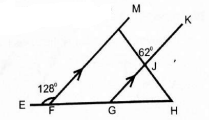
- Ann received a salary of sh. 30000 per month. She uses 3/20 of it for rent, for school fees and saves the rest. How much more does she save than use on rent?
- sh. 13500
- sh. 7500
- sh.9000
- sh. 18000
- What is the value of 4.8 x 0.084?
16.8- 0.0024
- 2.4
- 0.24
- 0.024
- Draw triangle ABC in which AB=6cm, BC= 10cm and AC = 8cm. Draw a circle to touch the points of the triangle ABC. What is the radius of the circle?
- 5cm
- 4cm
- 2cm
- 10cm
- A bottle holds 2.816litres of juice. If it has a height of 14cm, what is the diameter of the bottle in centimetres?
- 128
- 8
- 64
- 16
- What is 7869.85872 rounded off to the nearest hundredths?
- 7869.86
- 7869.85
- 7870
- 7869.859
- What is the value of x in
2(x+5) − 14 = 36- 30
- 6
- 20
- 22½
- On a certain day a trader spent sh. 8000 to buy 20 textbooks and then sold them making a profit of 15%. For how much did the trader sell each textbook?
- sh. 400
- sh. 460
- sh. 920
- sh. 600
- What is the total surface area of the figure drawn below?
- 360cm2
- 480cm2
- 408cm2
- 720cm2
- Which of the following will not form a right angled triangle?
- 24cm, 32cm, 40cm
- 18cm, 80cm, 82cm
- 9cm, 16cm, 25cm
- 15cm, 20cm, 25cm
- Three containers are capable of holding 54 litres, 72litres and 90litres respectively. Find the capacity of the largest container which can be used to fill each one of them exactly?
- 18
- 540
- 270
- 1080
- The hire purchase price of a motor bike is sh. 97860. Allan paid a deposit of sh. 3000 and 30 equal monthly installments. How much was each instalment?
- sh. 1000
- sh. 2262
- sh. 3262
- sh. 786028.
- What is the sum of faces, edges and vertices of an open rectangular prism?B
- 26
- 18
- 25
- 14
- What is the smallest number when divided by 12, 20 or 36 the remainder is always 4?
- 180
- 176
- 8
- 184
- The following diagram shows an athletic track whose dimensions are given in metres. The ends of the track are semi circular. Kimula ran round the track twice. What distance did he cover?
- 528m
- 792m
- 1056m
- 748m
- Four men working at the same rate would take 6 days to clear a piece of land. How many more men are needed in order to complete the work in 4 days?
- 6
- 4
- 8
- 2
- The pie chart below shows how Maina spents his January salary of sh. 36000.
How much more did he spend on food than on rent?- sh. 9000
- sh. 10500
- sh. 2000
- sh. 11000
- A wheel covers a distance of 7.92km after making 3000 revolutions. What is the radius of the wheel in metres?
- 0.42m
- 0.84m
- 2.52m
- 1.26m
- A trader sold 1.5 tonnes of rice in 3kg packets. How many packets were sold?
- 4500
- 1500
- 500
- 250
- What is the possible value of y in the inequality below
3y + 6 > by − 9?- 5
- 4
- 6
- 15
- Find the area of the figure below
- 30cm2
- 56.52cm2
- 86.52cm2
- 48.00cm2
- The masses of 8 pupils were recorded as 35kg, 32kg, 28kg, 25kg, 38kg, 40kg and 37kg. What was the median mass?
- 30
- 33.5
- 321/5
- 34
- Zainabu bought the following items from a wholesale shop
2kg of rice @ sh. 150
2 - 2kg packets of wheat flour@sh/ 140
1kg of sugar@sh. 124
2packets of tea leaves for sh. 120
She paid using two notes of sh. 500. How much balance did she receive?- sh. 824
- sh. 176
- sh. 114
- sh. 124
- Agnes and John shared money in the ratio of 5:3. Agnes got sh. 1800 more than John. How\ much money did John get?
- sh. 3000
- sh. 1080
- sh. 2700
- sh. 67540.
- Express 12½% as a ratio
- 1:8
- 25:200
- 25:2
- 1:4
- Omondi covered 325km. If he left Nairobi at 8.15am and reached Meru at 11.30am, calculate the speed?
- 90km/h
- 125km/h
- 25km/h
- 100km/h
- A rectangle measuring 32cm long and 18cm wide has an equal area as a square. Find the perimeter of the square?
- 96cm
- 144cm
- 576cm
- 24cm
- Calculate the value of the largest angle in the figure below?
- 32°
- 54°
- 62°
- 64°
- Find the value of 3c + 4d + 2b given that d = 3, c = ½b and b = 2
(cd)- 21/9
- 16
- 10
- 24/5
- Find the area of the shaded part in the figure below
- 42cm2
- 105cm2
- 21cm2
- 31.5cm2
- An open cylindrical tin has a diameter of 14cm and has a height of 10cm. What is its capacity in millilitres when half full?
- 1540ml
- 1496ml
- 748ml
- 770ml
- The mean mass of 5 girls is 15kg. The average mass of the first three girls is 17kg. What is the total mass of the remaining two girls?
- 12
- 19
- 24
- 2
- A square plot has an area of 3600m2. It was fenced round using 4 strands of wire. What length of wire was needed?
- 240m
- 60M
- 960m
- 360m
- Which of the following is not a property of a square?
- Diagonals are equal
- All sides are equal
- Opposite sides are parallel
- Opposite angles are not equal
- Karauri recorded his speed in a graph as shown below.
What was his average speed for the whole journey?- 40km/h
- 22½ km/h
- 45km/h
- 90km/hr
MARKING SCHEME
- B
- A
- A
- C
- D
- B
- B
- A
- A
- B
- C
- D
- A
- B
- B
- D
- C
- D
- A
- D
- A
- C
- B
- C
- A
- A
- C
- C
- D
- C
- D
- C
- A
- C
- B
- C
- B
- B
- C
- A
- D
- A
- D
- A
- C
- D
- C
- C
- D
- A
Creative Arts & Social Studies Questions and Answers - Grade 5 End Term 1 Exams 2023 Set 1
ART/CRAFT.
- All the following materials may be needed for thonging except a
- belt.
- leather.
- mallet.
- Knife.
- Which of the following indigenous crafts can be woven?
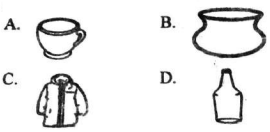
- Mundia drew a picture like the one drawn below.
The type of drawing above is called- observation drawing
- imagination drawing.
- stationary drawing.
- still life drawing.
- Komboyo wants to practice crayon etching technique. Which of the following pairs of items does he need?
- Black ink, celotape.
- Toothpick, plasticine.
- Black ink, beeswax.
- Paraffin wax, plasticine.
- Which of the following lists consists of items needed when making an expandable folder?
- Manila paper, ruler, glue.
- Pencil, needle, crayon.
- Water, scissors, cotton wool.
- Soap, eraser, glue.
- Study the diagram below.
Light and dark effects have been created using- stippling technique.
- smudge technique.
- crayon etc ing technique.
- cross hatching technique.
- When mounting artwork, what is the use of adhesives?
- Making the frame.
- Decorating the cutouts.
- Cutting out pictures.
- Sticking the cutouts.
- Clay items cannot be decorated using
- stamping.
- scratching.
- pasting.
- incising.
- Which of the following shows a glove puppet?
- Painting or. fabric can be done using
- needles.
- sponges.
- wires.
- sticks.
MUSIC.
- Which of the following French rhythms represents short sounds
- Ta-te
- Taa
- Taa - taa
- Taa-aa
- Below is an example of a percussion instrument.
The instrument above cannot be tuned by- tightening the laces.
- exposing the membrane to the heat from fire.
- adjusting the bridge.
- putting it in the sun.
- All the following members of the community can practice folk dances except
- men.
- women.
- boys.
- babies.
- A group of learners was asked to mention some items that can be used to improvise a drum.
Mercy: - clay.
Alice: - sand.
Lucy: - Log.
Joyce: - Wire.
Who among the learners mentioned a correct item?- Mercy
- Lucy
- Alice.
- Joyce.
- The East African Community Anthem is usually sung in
- mother tongue.
- English.
- Kiswahili.
- English and Kiswahili.
- Head joints and middle joints are parts of a
- guitar.
- descant recorder.
- flute.
- drum.
- Which of the following is an example of a percussion instruments.
- Below is a musical instrument called nzumari.
The instrument drawn above is played by the- Abakuria.
- Ameru
- Abagusii.
- Mijikenda.
- Which of the following hand signs represents solfa name re?
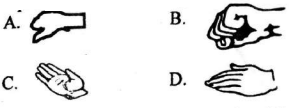
- Which of the following lines is found in the third verse of the Kenya National Anthem?
- With hearts both strong and true.
- In common bond united.
- Firm may we stand to defend.
- Justice be our shield and defender.
SOCIAL STUDIES.
- All the following are not cardinal points of a compass except
- south east.
- north west.
- south.
- south west.
- Sanaipei was asked to name an industry that deals in wheat products. Which of the following would be the correct response from Sanaipei?
- Fruit canning industry.
- Bakery industry.
- Creamery industry.
- Sawmill industry.
- The diagram below represents a type of population
The type of population represented above can be described as- straight.
- scattered.
- clustered.
- linear.
- Who among the following people depend on each other for the exchange of goods with money?
- Teachers and pupils.
- Traders and buyers.
- Police officers and thugs.
- Children in school.
- The county government gets its money from all the following sources except
- dues paid by tourists visiting the counties.
- money from land rates.
- rents from county offices.
- grants from the national government.
- Who among the following leaders in children's government in school maintains order in the classroom?
- President
- Games president
- Class representative
- Deputy president
- A situation where a child is forced to do hard work and is underpaid is called
- human rights.
- child abuse.
- child labour.
- interdependence.
- All the following are aspects of our traditional culture. Which one is not?
- The foods we eat.
- Our religions.
- The way we build our houses.
- The curriculum we follow in school.
- A cultural centre is an example of
- historic built environments.
- recreation facilities..
- physical features.
- permanent buildings.
- During rainy seasons,
- farmers harvest their farm produce.
- farmers carry out weeding in their farms.
- animals do not get sufficient pasture.
- there's no adequate water for domestic and farm uses.
- Below is a source of heat.
Which of the following fuels can best be used with the item above?- Firewood
- Charcoal
- Diesel
- paraffin
Use the map of Kenya below to answer questions 32 to 35
- The country marked V is most likely to be
- Sudan.
- Tanzania.
- Somalia.
- Ethiopia.
- The mountain marked S is called mount
- Kenya.
- Marsabit.
- Kulal.
- Longonot.
- The relief region marked R is the
- Lake basin.
- Nyika plateau.
- Rift Valley.
- Highlands.
- The main language group that lives in the area marjked xxx is
- Bantu.
- Nilotes.
- Semites.
- Cushites.
CHRISTIAN RELIGIOUS EDUCATION
- Who among the following was a dreamer according to the Bible?
- Pharaoh
- Joseph
- Jesus
- Moses
- The king who asked for wisdom from God was king
- Nebchadnezzar.
- Ahab.
- Saul.
- Solomon.
- Jesus Christ performed all the following miracles except
- changing water into wine.
- turning a stick into a snake.
- walking on water.
- Raising the dead.
- Selfishness means
- taking care of you and your friends.
- thinking about your neighbours.
- thinking only about yourself.
- helping other people whenever they need your help.
- The first book in the New Testament is called
- Genesis.
- Matthew.
- Malachi.
- Revelation.
- People of Israel were slaves in Egypt under
- Pharaoh.
- Moses.
- Pharisees.
- Joshua.
- Joseph's brothers hated him because he was
- given a coat of many colours.
- a young handsome man.
- liked most by Jacob their father.
- a close friend to Pharaoh.
- In order for Zacchaeus to see Jesus, he
- told the people in the crowd to give way.
- climbed a tree.
- used a tall ladder.
- ran ahead of the multitude.
- Abraham wanted to sacrifice his son called
- Isaac
- Samuel
- Paul
- Jonathan
- Jesus used __________________________ to teach people.
- proverbs
- stories
- riddles
- parables
- All the following are good practices for a Christian. Which one is not?
- Respecting one another.
- Helping the old.
- Abusing our enemies.
- Visiting the sick.
- The Philistine giant killed by David was called
- Goliath.
- Belshaazar.
- Pharaoh.
- Naboth.
- When Jesus raised the dead, He portrayed His power over
- diseases
- people
- death
- satan
- When the big fish vomited Jonah, he went and preached in the city of
- Tarshish.
- Capernaum.
- Caisea.
- Nineveh.
- Before Jesus calmed the storm, He was
- sleeping.
- preaching.
- fasting.
- praying.
ISLAMIC RELIGIOUS EDUCATION
- Which of the following is referred to as the opening chapter in the Qur'an?
- Al-Nasr
- Al-Walid
- Al-Kariim
- Al-Fatiha
- Surah An-Nas means the
- men.
- wind.
- dawn.
- elephants.
- I recite Al-Muawwidhatayan before I
- play.
- wake up.
- sleep.
- eat.
- All the following lessons are learnt in surah Al-Ikhlas except
- evil people have bad endings.
- Allah is one.
- Allah is unique.
- Allah controls all things.
- All the following are positive uses of social media. Which one is not?
- Listening to Qasida from a mobile phone.
- Creating dawah groups on Whatsapp.
- Sending abusive messages to those who wrong us.
- Sharing homework questions using smart phones.
- Which among the following is a vice?
- Humility
- Obedience
- Kindness
- Selfishness
- Who among the following angels is responsible for record taking?
- İsrafil
- Raqib
- Izrail
- Munkar
- Surah Al-Lahab can also be called
- Al-Walid.
- Al-Kariim.
- Al-Masad.
- An-Nas.
- The fourth swalah of the day is called
- Fajr.
- Asr.
- Dhuhr.
- Maghrib.
- When eating our food, we should
- eat it while standing to save time.
- use the right hand as advised by prophet Muhammad (SAW)
- cat from the middle of the plate.
- be sending Qur'an verses to our friends using our mobile phones.
- Praying is a way of
- securing a good place in paradise.
- speaking to Allah.
- drawing nearer and nearer to Allah.
- strengthening our faith in the religion.
- Which one of the following Islamic festivals is celebrated during childbirth?
- Milaud-un-Nabii.
- Eid-ul-Adhha.
- Aqiqah.
- Eid-ul-Fitr.
- How many pillars of Iman are there in the Muslim religion?
- Three.
- Four.
- Five.
- Six.
- Which one of the following is not an example of akhlaq?
- Feeding domestic animals.
- Protecting seedlings.
- Spending our money.
- Grazing animals.
- Which one ofthe following practices enables us observe hygiene?
- Taking wudhu
- Praying
- Helping the needy
- Fasting
MARKING SCHEME
- A
- C
- D
- C
- A
- D
- D
- C
- A
- B
- A
- C
- D
- B
- C
- B
- A
- D
- C
- B
- C
- B
- D
- B
- A
- C
- C
- D
- A
- B
- B
- D
- A
- A
- C
C.R.E
- B
- D
- B
- C
- B
- A
- C
- B
- A
- D
- C
- A
- C
- D
- A
I.R.E
- D
- A
- C
- A
- C
- D
- B
- C
- D
- B
- B
- C
- D
- C
- A
Integrated Science Activities Questions and Answers - Grade 5 End Term 1 Exams 2023 Set 1
SCIENCE AND TECHNOLOGY.
- Which of the following parts of a computer is used for selection?
- CPU
- Monitor
- Mouse
- Cables
- Aaron drew the following device on the white board.
He later asked his classmates to name it. What was their correct answer?- Keyboard
- Printer
- VDU
- Mouse.
- On which part of a computer do we read what we type?
- Monitor
- Keyboard
- CPU
- Mouse
- Which among the following substances is a gas?
- Saliva
- Dust
- Stone
- Air
- When we breathe polluted air
- we can develop breathing problems.
- we can suffer from sore eyes.
- our skin can be rashy.
- we can suffer from severe diarrhoea.
- A Grade 4 learner put a coin in a basin of water as shown below.
The coin went down into the water. We can say that the coin is a- solid.
- floater.
- material.
- sinker.
- Below is a type of teeth.
Which of the following statement is true? It- is chisel shaped.
- has cusps and ridges.
- has one root.
- is used for cutting and biting.
- During an experiment, some learners set up an experiment as shown below.
The learners could not reach the right conclusion because- they used two balloons.
- the stand they used was not very firm.
- the balloons they used were too light.
- they inflated both balloons.
- Which among the following levers has the position of the load, effort and fulcrum at the same point as a broom when at work?
- Which of the following pairs of small animals is made up of vertebrates only?
- Millipede, centipede.
- Butterfly, snake
- Snail, lizard
- Chameleon, gecko
- All plants
- make their own food.
- die.
- are green.
- move from place to place.
- In the human digestive system, saliva is produced in the
- small intestines.
- stomach.
- mouth.
- large intestines.
- A fish is like a tortoise in that they both
- have scales.
- breathe by gills.
- use their lung for breathing.
- lay fertilized eggs.
- Mawingu saw a type of cloud with the following characteristics:
- Formed low in the sky.
- Looked mountainous.
- Covered the whole sky.
The type of clouds Mawingu saw was also likely to be- a sign of rain.
- white and feathery.
- a sign of fine weather.
- having flat bottoms.
- Which one of the following is a characteristic of all animals? All animals
- make their own food.
- lay eggs.
- die.
- give birth to live young ones.
AGRICULTURE.
- Below is a domestic animal reared in Kenya
Which of the following statements is true about the animal drawn above? It- provides the farmer with quality milk.
- is used to guard our homes.
- gives two food products.
- gives only one food product.
- Which of the following is an example of vegetables?
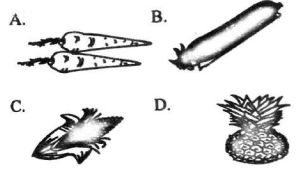
- We eat the leaves of
- Carrots.
- Onions.
- bean plants.
- maize plants.
- Which of the following is an example of cereals?
- Avocado
- Cucumber
- Spinach
- Rice
- Which of the following farm tools is needed to supply water to seedlings in a nursery bed?
- Mwikali collected the following materials in readiness to prepare compost manure:
- Ash.
- Old rags. manure.
- Kitchen refuse.
- Maize stalks.
- Farmyard
- Broken bottles.
Which pair of materials was not needed?- i, ii
- ii, vi
- ii, v
- iii, vi
- Some learners carried out an experiment like the one below to investigate a property of soil.
Which of the following statements is true about the set up above?- Soil type X is good for modelling.
- W was loam soil.
- For modelling, soil type Y was the best.
- Soil type Y was the best for farming.
- Which one of the following is a tiny seeded crop?
- Sunflower
- Maize
- Pumpkin
- Sugarcane
- Which of the following farm animals offers services only?
- Camel
- Dog
- Pig
- Chicken
- All the following are farm uses of water except
- irrigation.
- watering animals.
- washing farm tools.
- transport.
HOMESCIENCE.
- All the following foodstuffs can be bought from a general grocery except
- onions.
- milk.
- carrots.
- tomatoes.
- Makali ate ugali and spinach for his lunch. Which of the following would he add to make his meal a balanced diet?
- Avocado
- Chips
- Beans
- Kales
- All the following are protective foods. Which one is not?
- Apples
- Cabbage
- Oranges.
- Meat
- Kitchen utensils that can break easily are said to be
- brittle.
- fragile.
- vulnerable.
- weak.
- Kapano asked some of his friends to name the foods that can be fried
Wanyama: - Meat
Kwamboka: - Mandazi
Mwakazi: - Bread
Husna: - Pork
Who among then was not correct?- Wanyama
- Kwamboka
- Mwakazi
- Husna
- The diagram below shows a source of heat.
The source of heat drawn above uses- firewood.
- petrol.
- paraffin.
- charcoal.
- Machoine's school shoes are made of leather. Which of the following methods can be used to clean them daily?
- Washing
- Soaking
- Painting
- Polishing
- A dustpan is used for
- collecting rubbish.
- removing cobwebs.
- cleaning cemented floors.
- drying earthen floors.
- Which one of the following foodstuffs needs the highest standard of hygiene when preserving?
- Dry maize
- Milk
- Fruits
- Packed rice
- In laundry work, which of the following items is used in airing garments?
PHYSICAL HEALTH EDUCATION.
- Which of the following sports activities must be practised in a swimming pool?
- Front crawl.
- Back hand throw.
- Passing
- Jumping for height
- Which one of the following may be needed when improvising a ball?
- Iron sheets
- Short wires
- Long nails
- Rubber bands
- Below is a player practising a game.
The player drawn above is practising- chest pass.
- instep pass.
- kneeling overhead throw.
- under arm pass.
- Muli and her sister want to practise bounce pass. Which of the following play materials do they need? A
- ball.
- rope.
- cone.
- beanbag.
- Which of the following items below can be used in batting games?
- The type of roll demonstrated below can be applied in gymnastics.
The roll type above is called- forward roll.
- bear roll.
- backward roll.
- egg roll.
- A floater can be used by a beginner in
- athletics.
- swimming.
- frisbee.
- soccer.
- Choose a pair of harmful drugs used in the community.
- Soda and juice
- Tea and coffee
- Alcohol and cigarette.
- Paraffin and diesel.
- Study the picture below.
The sport activity demonstrated above is called- standing long jump.
- standing start.
- instep pass.
- underhand pass.
- In athletics, the point at which races end is called the
- start point.
- finish point.
- shallow end.
- landing pit.
- Single handed rim catch can be practised in
- football.
- handball.
- batting games.
- frisbee.
- Which one of the following is not an example of track events?
- Relays
- Athletics
- Run through finish
- Crouch surface
- For the improvision of a relay baton, all the following may be needed except a
- piece of wood.
- mass of cotton wool.
- manila paper.
- maize cob
- Which one of the following is not a step in hurdles?
- Take off
- Clearance
- Backstroke
- Flight
- Which one of the following is not expected in a first aid kit?
- Methylated spirit.
- Painkillers.
- A roll of bandage.
- A hammer.
MARKING SCHEME
- C
- B
- A
- D
- A
- D
- B
- D
- C
- D
- B
- C
- A
- A
- C
- D
- A
- B
- D
- C
- D
- D
- A
- B
- D
- B
- C
- D
- B
- C
- A
- D
- A
- B
- C
- A
- D
- C
- A
- B
- A
- B
- C
- A
- B
- D
- D
- B
- C
- D
Shughuli za Kiswahili Questions and Answers - Grade 5 End Term 1 Exams 2023 Set 1
Soma mazungumzo yafuatayo kisha ujibu maswali 1-5.
(Wazazi wanajadiliana na wana wao kuhusu namna na umuhimu wa kuwa na afya bora)
Baba: Mke wangu, ni siku nyingi hatujazungumza na kina Tina kuhusu masuala ya kibinafsi. (Kimya kinapita) Hebu waite tuzungumze nao.
Mama: Sawa mume wangu (anasimama dirishani akitazama nje) Tinaa!..... Ramaa!
Tina na Rama: Naam mama!
Mama: Hebu njooni humu ndani upesi (Kwa mumewe) Watoto siku hizi wakipata fursa, hawakai. Ni wao na mchezo. (Watoto wanaingia wakihema)
Baba: Wanangu, tumewaita hapa ili tuzungumze kuhusu umuhimu wa kuwa na afya bora. Ketini. (Wanaketi)
Mama: Kwanza, Tina na Rama, lazima mjue namna ya kudumisha afya bora.
Tina: Nadhani njia mojawapo ni kudumisha usafi, kula vyakula salama na kamili na kufanya mazoezi.
Baba: Vyema Tina. Tunapokuwa na afya bora, miili yetu haipatwi na magonjwa mara kwa mara.
Rama: Tena akili zetu hufanya kazi vyema na kuboresha matokeo ya shughuli zetu zikiwemo za masomo.
Mama: Si hayo tu, tunapokuwa na afya bora, sisi hupendeza na kuvutia maana miili yetu huwa na maumbo ya asili, si miili iliyokonda na kuonyesha mifupa.
Baba: Ningependa kuwa kwanzia leo kila mmoja wetu aliakikishe ubora wa afya yake kwa kutenda haya na mengine yaliyo mema.
Tina na Rama: Sawa baba.
- Baba alitaka kuzungumza na watoto wao kuhusu
- matokeo ya mtihani.
- michezo waliyokuwa wakicheza.
- masuala ya kibinafsi.
- vipindi walivyovipenda.
- Kabla hawajaitwa, Tina na Rama walikuwa wapi?
- Chumbani
- Nje wakicheza
- Wakipumzika nje
- Sebuleni
- Pendekezo la kula vyakula salama na kamili lilitolewa na
- Tina
- Rama
- mama
- baba
- Kulingana na baba, tunapokuwa na afya bora,
- matokeo ya shughuli zetu huwa mazuri.
- miili yetu huweza kupatwa na magonjwa.
- miili yetu huwa na maumbo asilia isiyokonda.
- hatupatwi na magonjwa mara kwa mara.
- Kulingana na mazungumzo haya,
- Rama na Tina hawapendi kucheza.
- hakuna haja ya kudumisha afya bora.
- wazazi waliotajwa wanawajali watoto wao.
- watu wa familia hiyo wanapenda sana kucheza.
Soma kifungu kifuatacho kisha ujibu maswali 6 hadi 9.
Amina alikuwa mwanafunzi wa Gredi ya tano katika shule ya Shaurimoyo. Mama yake alimwambia awe mwangalizi pale nyumbani alipokuwa sokoni. Amina alikuwa na kaka wawili na dada wawili. Ndugu zake Amina walikuwa watiifu.
Jumamosi moja, mama yao alienda sokoni kama kawaida. Alimwambia Amina awaelekeze ndugu zake kufanya shughuli za pale nyumbani. Amina aliwaambia dada zake waoshe vyombo na kusafisha nyumba. Kaka zake walitakiwa kuyanyunyizia maua maji na kuwashughulikia mbuzi wao. Baada ya shughuli hizo zote, watoto hao walikaa na kutulia huku wakimngoja mama yao atoke sokoni.Mama yao aliporudi, alifurahi sana kuona jinsi nyumba yao ilivyokuwa safi. Aliwapa wasichana maparachichi na wavulana miwa kwa kazi nzuri walizofanya. Wote walifurahi.
- Familia hii ina jumla ya watoto wangapi?
- Wanne
- Sits
- Watano
- Watalu
- Ikiwa kila msichana alipewa parachichi moja, mama alileta maparachichi mangapi?
- Matano
- Sita
- Manne
- Matatu
- Baada ya kumaliza kazi zote, watoto
- walikaa na kumngoja mama yao.
- walienda nje kucheza.
- waliwasha runinga na kutazama vibonzo.
- walifurahia maparachichi na miwa.
- Mama alipotoka sokoni alifurahishwa na
- utulivu wa watoto wake.
- usafi wa nyumba yao.
- bidii ya watoto wake.
- ladha ya matunda aliyoleta.
Soma kifungu kifuatacho kisha ujibu maswali 10 hadi 12.
Moto! Moto! Hii ilikuwa sauti ya kutisha kwelikweli. Ingawa nilikuwa na usingizi kiasi, nilinyanyuka kutoka kitandani kuangalia ilipotoka sauti ile. Nilichungulia dirishani. Nje, kila mmoja alikuwa akikimbia huku na kule kujaribu kuuzima moto katika nyumba ya Bi. Faya.
"Siachwi nyuma!" Nilijiambia huku nikishuka vidato. Nilipofika, kila mmoja alikuwa mbioni kuokoa hali. Ghafla, nilichukua ndoo iliyokuwa na mchanga nikampa mzee Mapunda. Naye hakusita. Aliumwaga kwenye kitovu cha moto ule. Haikutosha, Mwang'ombe akaleta ndoo nyingine huku kipusi akimimina mapipa kadhaa ya maji motoni. Baada ya muda mfupi, moto wote ukawa umezima.
- Mwandishi aliposikia sauti ya kutisha, alikuwa wapi?
- Kitandani akilala.
- Chumbani akifanya usafi.
- Nje akizima moto.
- Sebuleni akitazama runinga.
- Mwandishi aliamua kuwa haachwi nyuma kwa kuwa alikuwa
- na usingizi kiasi
- na moyo wa kusaidia.
- na ndoo yenye mchanga.
- mwenye bidii kwelikweli.
- Wakati wa ajali hii ya moto, Bi Faya alikuwa wapi?
- Sokoni
- Dukani
- Chumbani
- Hatujaelezwa
Soma kifungu kifuatacho kisha ujibu maswali 13 hadi 15.
Siku iliyofuata, mfalme simba alikuwa ameandaa mashindano yaliyotakiwa kuwahusisha wanyama wote. Hata hivyo, kunao wengine waliokuwa wameomba ruhusa kuwa wasingeshiriki. Jioni ya siku ya Ijumaa, mbweha alipita kote huku akipuliza firimbi ya kutangaza mashindano ya siku iliyofuata, mashindano ya kucheza muziki.
Wanyama waliotakiwa kushiriki walikuwa pundamilia, kinyonga na sungura. Watatu hawa walifika wakiwa wamejipodoa vilivyo. Pundamilia alikuwa amepakwa rangi nyeupe na nyeusi kwa namna ya mistari, sungura alikuwa amenyolewa mtindo wa shore na kuliacha shungi la nywele utosini huku kinyonga akiwa na mavazi mapya yaliyomkaa sawasawa.
Baada ya kila mmoja kuchukua nafasi yake na ngoma kuanza, mvua kubwa ilianza kunyesha. Kila mmoja alitimua mbio kumwacha maskini kinyonga akinyeshewa na nguo zake mpya!
- Mashindano haya yangefanyika siku ya
- Ijumaa
- Alhamisi
- Jumamosi
- Jumapili
- Wanyama wangapi walitarajiwa kushiriki katika mashindano haya?
- Watano
- Wawili
- Wanne
- Watatu
- Unadhani ni kwa nini kinyonga alibaki wenzake wakikimbia?
- Hawezi kuenda haraka.
- Alitaka kubaki pale.
- Alitaka anyeshewe.
- Alikataa kuwafuata mbio.
Soma kifungu kifuatacho. Chagua jibu lifaalo zaidi kati ya yale uliyopewa.
Siku hiyo tulikuwa tumeingoja kwa hamu na ghamu. Sote tulifika ___16___ tukiwa tayari kuabiri___17___kuelekea mjini Meremeta. Hii ilikuwa mara yangu ya ___18___ kuenda huko. Sikuwa nimewahi kuenda huko. Tuliingia ___19___ tukiwa na furaha sana. Mara dereva alitia gari ufunguo na safari
___20___.
| A | B | C | D | |
| 16. | asubuhi | shuleni | adhuhuri | usiku |
| 17. | baiskeli | basi | ndege | meli |
| 18. | moja | mwisho | tatu | kwanza |
| 19. | njiani | safari | basini | barabarani |
| 20. | ikaanza | ikaisha | ikaendelea | ukaanza |
Katika swali la 21-30, jibu swali kulingana na maagizo uliyopewa.
- Katika sentensi chura mnono aliteleza akazama, nomino ni
- mnono.
- chura.
- aliteleza.
- akazama.
- Chagua orodha ya vitenzi pekee. A
- Kiazi, bata, daftari.
- Chota, peleka, kataa.
- Sana, zaidi, polepole.
- Chini ya, kando ya, mbele ya.
- Ni gani kati ya maneno haya ni kihisishi?
- Lo!
- Katikati ya
- Mweupe
- Leo
- Kati ya orodha hizi, ni ipi ina mavazi, kike na kiume
- Kamisi, chupi, soksi.
- Koti, rinda, kofia
- Suti, soksi, tai
- Suruali, kaptura, sidiria
- Kamilisha methali:
Mwana akibebwa- usilevyelevye miguu.
- ndivyo akuavyo.
- kuzimu enda kiona.
- hutazama kisogo cha nina.
- Ni upi wingi wa sentensi ifuatayo?
Mkoba wenyewe ni huu.- Mikoba zenyewe ni hizi.
- Mikoba yenyewe ni hii.
- Mkoba zenyewe ni hizi.
- Mkoba yenyewe ni hii.
- Ni rangi gani hapa haipo katika bendera ya taifa la Kenya?
- Nyeupe
- Nyeusi
- Manjano
- Kijani
- Nomino mayai inaweza kuorodheshwa katika ngeli gani?
- U-I
- KI-VI
- LI-LI
- LI-YA
- Kitenzi chapa katika kauli ya kutendea huwa
- chapia.
- chapwa.
- chapisha.
- chapiwa.
- Kamilisha tashbihi hii
Bwana Murefu ni mfupi kama- mlingoti.
- nyundo.
- kasuku.
- nguruwe.
MARKING SCHEME
- C
- B
- A
- D
- C
- C
- D
- A
- B
- A
- B
- D
- C
- D
- A
- A
- B
- D
- C
- A
- B
- B
- A
- C
- D
- B
- C
- D
- A
- B
English Language Activities Questions and Answers - Grade 5 End Term 1 Exams 2023 Set 1
Read the following conversation and then answer questions 1 to 5.
Juma: How are you doing Saida? I'm very sorry I couldn't visit you as we agreed. How was your weekend?
Saida: I am fine Juma. Maybe next time you will make it to my place for a visit. My weekend was not very bad, I thank God. We were to visit Omari in the hospital but I couldn't make it. I'm sorry.
Juma: Ooh, that is true. Kadzo, her sister and I managed to visit Omari at Medicare hospital. How come you did not show up?
Saida: I was looking after my sick grandmother. Since there's no one at home to take care of her, I had no option.
Juma: I'm sorry Saida. What is she suffering from?
Saida: According to the doctor, she is suffering from chronic pneumonia. She also has a problem in breathing. By the way, how is Omari?
Juma: After recovery, the doctor discharged him. However he will have to take a week's time rest. I would like to see you grandmother. Let us go and take care of her.
- How many children visited Omari in 3. Medicare hospital?
- Two
- Three
- Four
- Five
- Saida could not make it to Medicare hospital because
- she wasn't feeling well.
- she was taking care of her sick mother.
- she did not want to do so.
- she was taking care of another patient at home.
- Who had a breathing problem?
- Saida's grandmother
- Saida
- Omari
- Kadzo's sister
- According to the conversation, it is true to say that Juma is
- sick.
- careless.
- caring.
- impatient.
- What was Omari suffering from according to the conversation?
- Chronic pneumonia
- Breathing problem.
- We have not been told.
Read the passage and then answer questions 6 to 9.
Rats have very sharp senses especially those of touch and hearing. They are afraid of humans and can hear you coming long before you have a chance to see them. They are loners by nature, never will they get together to defend themselves if they are threatened. Rats can also be clever. They are smart by the way they steal eggs. A rat will hold an egg firmly with all four paws lying on its back so as not to break the egg while two or three others pull it away by its tail.
- According to the passage, what can rats sense very well?
- Touching and eating
- Hearing and defending.
- Eating and defending.
- Hearing and touch.
- However smart rats are, they cannot
- help one another stealing eggs.
- defend one another.
- hear approaching human beings.
- carry away eggs.
- The method rats use to steal eggs shows their
- cleverness
- speed.
- sharp senses.
- strength.
- According to this passage, unity in rats is seen when
- sensing touch and hearing.
- surviving lonely.
- stealing eggs.
- defending each other.
Read the passage and then answer questions 10 to 12.
I was born and brought up in a liberal home by African standards. We all cooked, washed the house, clothes and dishes. It did not matter whether you were a boy or a girl. We all went to school. Everyone was allowed to pursue their own interest and their opinions were heard and respected. We were taught to appreciate our strengths and work on our weaknesses. During school holidays, we were taught lifeskills involving activities like hunting, fishing and farming. Some of us would learn pottery and basketry. Back then, life was real, unlike today where almost everything is a fiction based on technology.
- Since both boys and girls did all the chores,
- girls suffered child labour.
- boys were exposed to child labour.
- equality was observed.
- parents became very lazy.
- Which of the following is not true according to the passage?
- Human beings have strengths and weaknesses.
- The writer is not a young person.
- There is a difference between life back then and now.
- Lifeskills are not very necessary today.
- During school holidays, the writer would learn all the following except
- weaving.
- hunting
- fishing.
- farming.
Read the passage and then answer questions 13 to 15.
Dog and her puppies lived on a farm where there was a well. The mother dog told the puppies not to go near the well or play around it. One of the puppies wondered why they should not go near the well and decided to explore it. He went to the well, climbed the wall and peeped inside there. He saw his reflection and thought it was another dog. The puppy saw that the "other dog" was imitating him and got very angry. He decided to fight the dog. He jumped into the well but there was no dog there! He cried for help until the farmer came and rescued him.
- The mother dog told the puppies not to
- swim in the well.
- play around the well.
- explore the well.
- play together.
- The puppy that climbed up the wall of the well
- saw his reflection in the water.
- saw another puppy in the well.
- followed his mother's instructions.
- died in the well.
- After the puppy cried for help in the well,
- the mother dog came to his rescue.
- he died immediately
- the farmer came and helped him.
- he swam out of the well.
Read the passage below. It contains blank spaces numbered 16 to 20. For each blank space, select the best alternative from the choices given.
Wambua and his family are farmers. They live in a big farm house. One day, Wambua went as usual to milk his cow. He had cleaned the cowshed the ___16___ night and left Maziwa, the ___17___cow to rest. When he woke up the following morning. Maziwa had a difficulty in breathing. She also did not welcome Wambua with her usual ___18___ Wambua called a ____19___ doctor who said Maziwa had a thorn in morning. her mouth which pricked her ___20___.
| A | B | C | D | |
| 16. | following | past | last | previous |
| 17. | daily | diary | dairy | daring |
| 18. | meow! | moo! | woof! | mee! |
| 19. | veterinary | witch | family | animal |
| 20. | woof | skin | gum | horn |
For questions 21 to 23, select the best article to complete the sentences.
- My cousin studies at _______________________ university.
- an
- the
- a
- then
- It was ______________________ honour to be warmly welcomed.
- the
- a
- at
- an
- ________________________ sun was shining bright in the morning.
- A
- An
- As
- The
In questions 24 to 26, select the best alternatives to fill the blank spaces.
- Kombora ____________________ take his son to school tomorrow.
- shall
- has
- will
- had
- Mumo and I _____________________ be practising in the field.
- would
- shall
- were
- could
- The porridge in the jug ___________________ not cold.
- has
- will
- hadn'
- is
For questions 27 to 30, choose adjectives in the given sentences
- My cat's fur is very soft.
- fur
- cat's
- soft
- very
- The blanket Ongeti bought was red.
- red
- blanket
- Ongeti
- bought
- Kafupi is the tallest boy in our class.
- class
- boy
- tallest
- Kafupi
- The food Tina prepared was delicious.
- Tina
- food
- delicious
- prepared
MARKING SCHEME
- B
- D
- A
- C
- C
- D
- B
- A
- C
- C
- D
- A
- B
- A
- C
- D
- C
- B
- A
- C
- B
- D
- D
- C
- B
- D
- C
- A
- C
- C
Mathematics Activities Questions and Answers - Grade 5 End Term 1 Exams 2023 Set 1
QUESTIONS
- In Babalao county, the total population of Grade 5 learners is 24 761. What is this number in words?
- Two thousand, four hundred and seventy six thousand and one.
- Two thousand, four hundred and seventy thousand and sixty one.
- Twenty four thousand, seven hundred and sixty one.
- Twenty four thousand, six hundred and seventy one.
- A teacher wrote the number 86 430 on the board. He later asked Nyang'au to state the total value of the underlined digit. What was Nyang'au's correct answer?
- 600
- 6000
- 60 000
- 60
- Grade five East has thirty five learners, Grade 5 North has 34 learners and Grade 5 south has 33 learners. What is the total number of Grade 5 learners to the nearest hundred?
- 102
- 200
- 202
- 100
- A number is divisible with 5 if the last digit is
- 2
- 0
- 0 or 5
- 5
- 48 farmers transplanted 16 seedlings each. How many seedlings were transplanted altogether?
- 768
- 64
- 668
- 54
- During Tuyu's birthday ceremony, 9 of his classmates attended. If 5 of them were boys, what part of the classmates were girls?
- 5/9
- 1/9
- 4/9
- 9/10
- There were 56 players to be ferried to a tournament. A motorbike rider carried 3 players per trip. How many players were carried in the last trip?
- 5
- 2
- 7
- 1
- Out of 2 642 sacks of maize harvested, 1 349 were sold and the rest kept in the store. How many sack were kept in the store?
- 1 293
- 3 991
- 1 283
- 3 891
- In the number 13.46, which digit is in the ones place value?
- 1
- 3
- 4
- 6
- A member of County Assembly shared 99 bales of maize flour equally to 9 families. How many bales did each family receive?
- 90
- 891
- 10
- 11
Use the map below to answer the following questions.
- Mawingu rode his bike from the police station to the school, went back to the police station and finally rode to the recreation facility. What distance did he cover?
- 110 m
- 141 m
- 196 m
- 282 m
- How far is it from police station to the recreation facility than from the school to the recreation facility?
- 141 m
- 29 m
- 31 m
- 33 m
Study the figure below and use it to answer the following questions.
- How many columns are in the figure above?
- 5
- 10
- 50
- 40
- How many rows are there?
- 10
- 40
- 50
- 5
- What is the area of the figure above?
- 10 square units.
- 55 square units.
- 50 square units.
- 40 square units.
- Wanyama's goat is 63 kg while his sheep is 69 kg. What is the total mass of the animals?
- 172 kg
- 132 kg
- 162 kg
- 122 kg
- Study the diagrams below.
How many jugs of water does Maria need to fill the sufuria?- 18
- 10
- 40
- 20
- Which of the following consists of wants only?
- Maize, beans
- Radio, television
- Banana, cabbage
- Rice, blouse
- A Mathematics lesson ended at 10.35 am. If the lesson started 2100 seconds ago, which of the following clockfaces shows the time the lesson started?
- Ali had a 90 kg sack of maize. He sold 20 kg and took 15 kg home for consumption and stored the rest. How many kilograms were stored?
- 65 kg
- 125 kg
- 35 kg
- 55 kg
- Some learners were asked to name the properties of a rectangle.
Yuda: - It has four right angles.
Pilato: - All sides are equal and parallel.
Kaisari: - It is a four sided figure.
Herode: - All the interior angles add up to 360°
Who among the learners was wrong?- Herode
- Pilato
- Kaisari
- Yuda
- Eight Grade 5 learners shared r exercise books equally. If one book remained, which of the following expressions can be used to find the total number of the books before sharing?
- (r+8) + 1
- 1 − (8xr)
- 8 − (1xr)
- (8+r) +1
- Kabambe was given 15 balloons to share with with his friends. p of them were white while 6 of them were blue. How many ballons were white?
- 21
- 20
- 9
- 10
- Which of the following is an obtuse angle
- Mr Karanga drew a diagram like the one drawn below
The diagran Mr. Karanga drew represents?- Clockwise turn.
- Quarter turn.
- Anti clockwise turn.
- Full turn.
- Which of the following is the next shape in the pattern below?
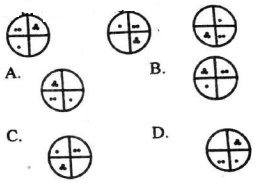
The table below shows the types of foods enjoyed by learners at Afyabora restaurant
| Type of food | No. of learners |
| Chips, fish | 15 |
| Ugali, matumbo | 8 |
| Rice, stew | 11 |
| Matoke, greens | 9 |
| Chapati, beans | 10 |
- What was the total number of learners who enjoyed chapati, beans and ugali, matumbo?
- 28
- 18
- 10
- 8
- Which food was least liked?
- Chips, fish
- Ugali, matumbo
- Rice, stew
- Matoke, greens
- How many more learners took chips, fish than those who took rice, stew?
- 26
- 15
- 4
- 11
- In total how many learners enjoyed different foods in Afyabora restaurant
- 73
- 43
- 63
- 53
MARKING SCHEME
- C
- B
- D
- C
- A
- C
- B
- A
- B
- D
- C
- C
- B
- D
- C
- B
- B
- B
- B
- D
- B
- A
- C
- A
- C
- A
- B
- B
- C
- D


